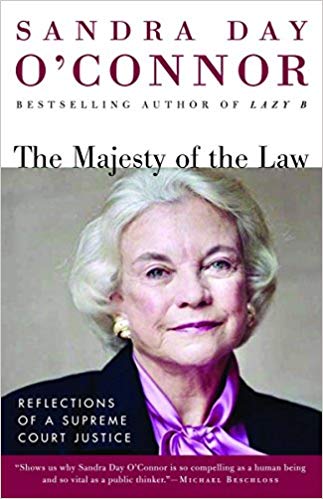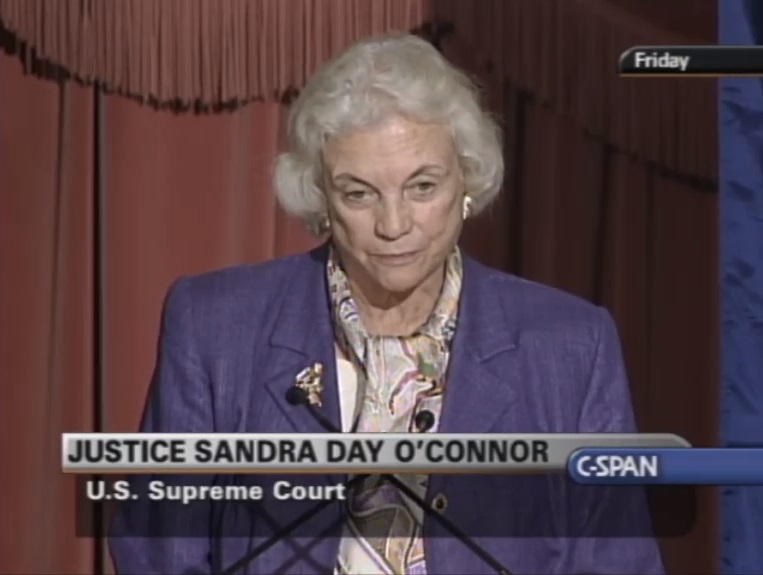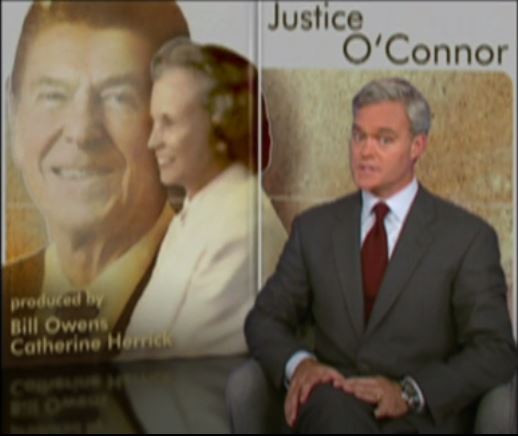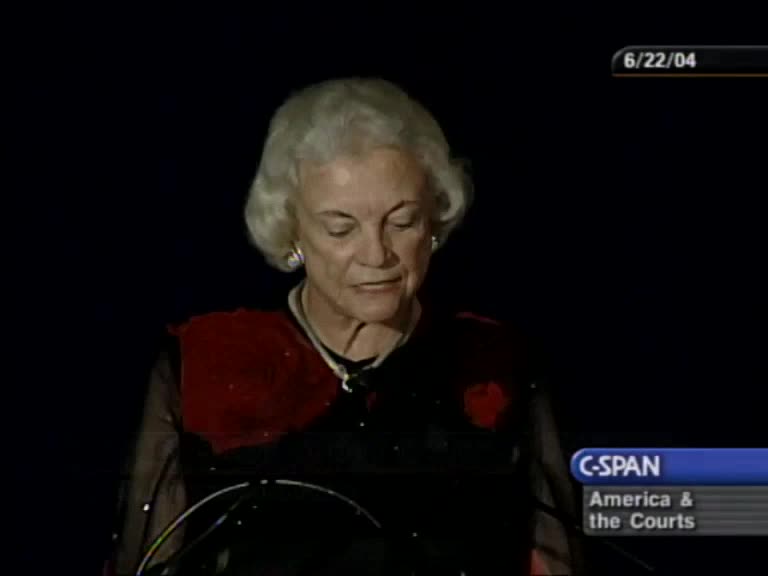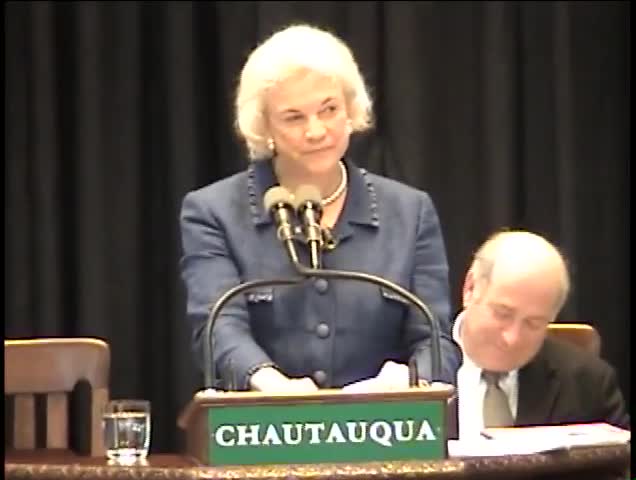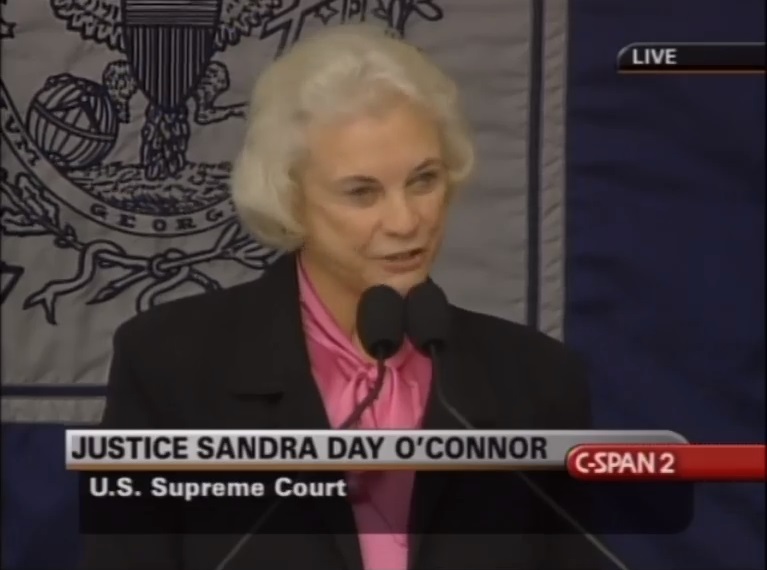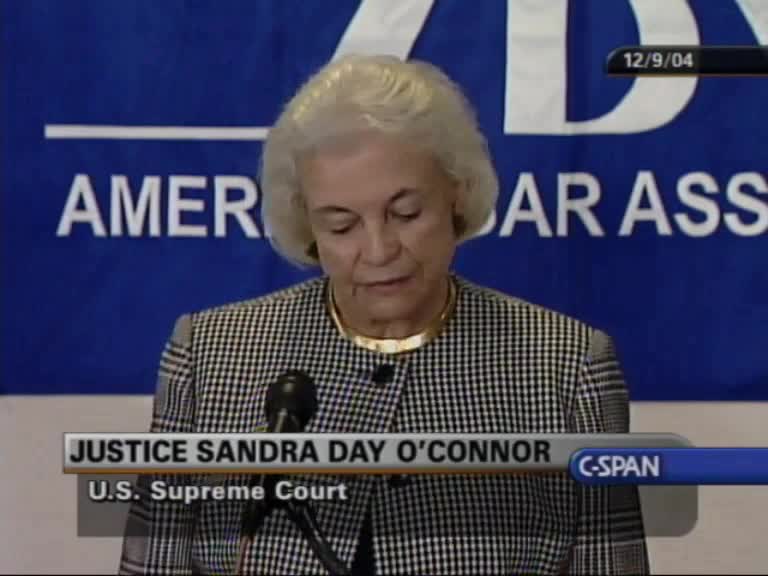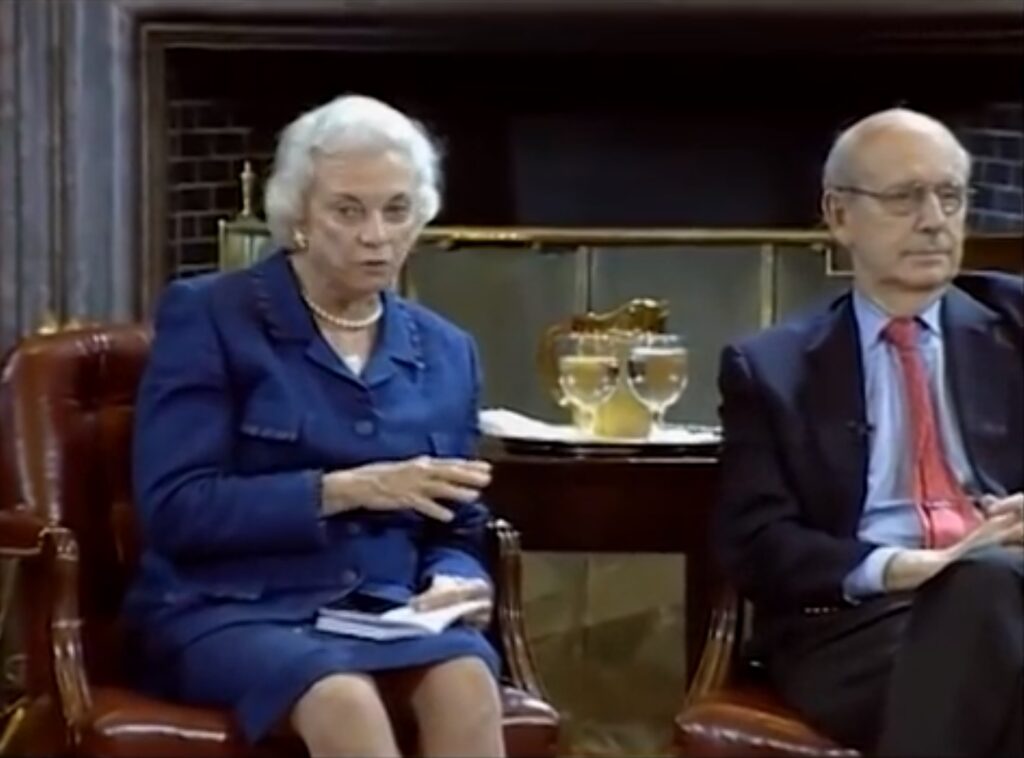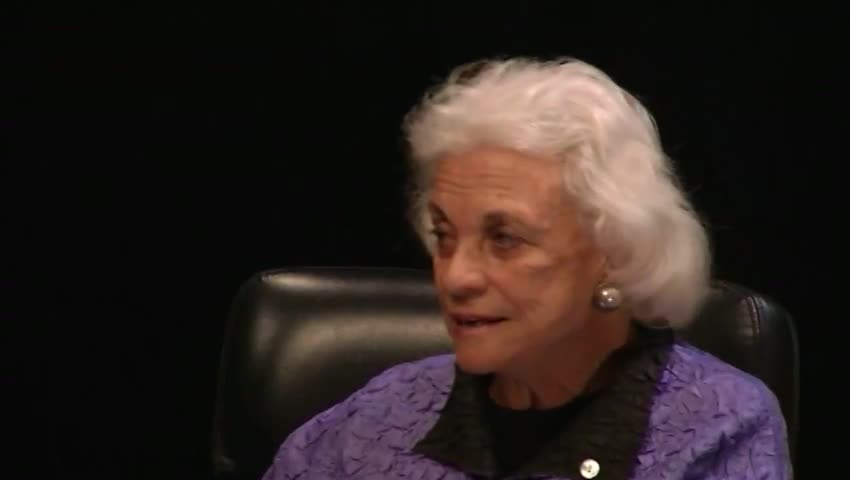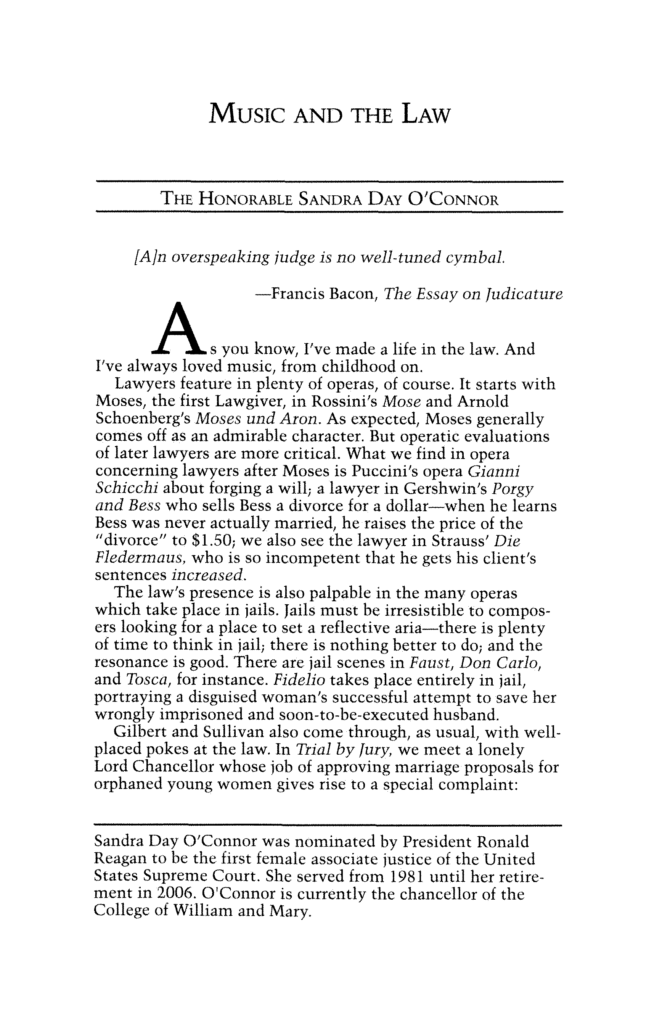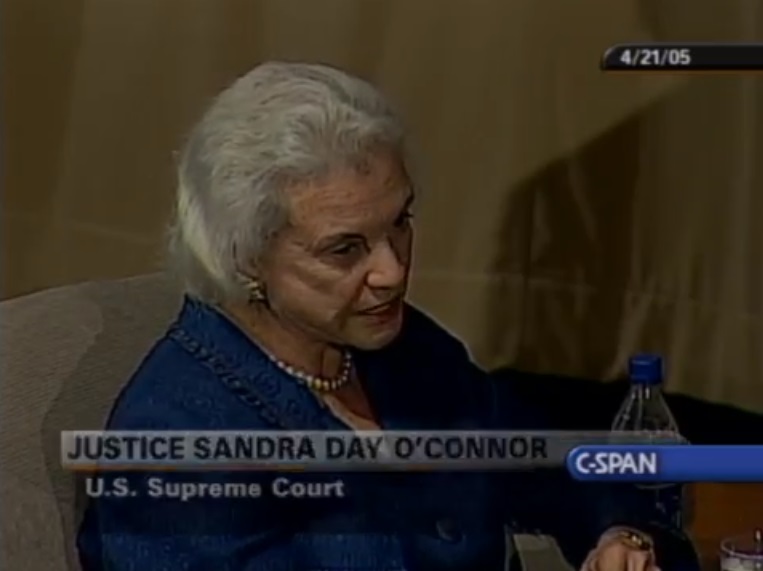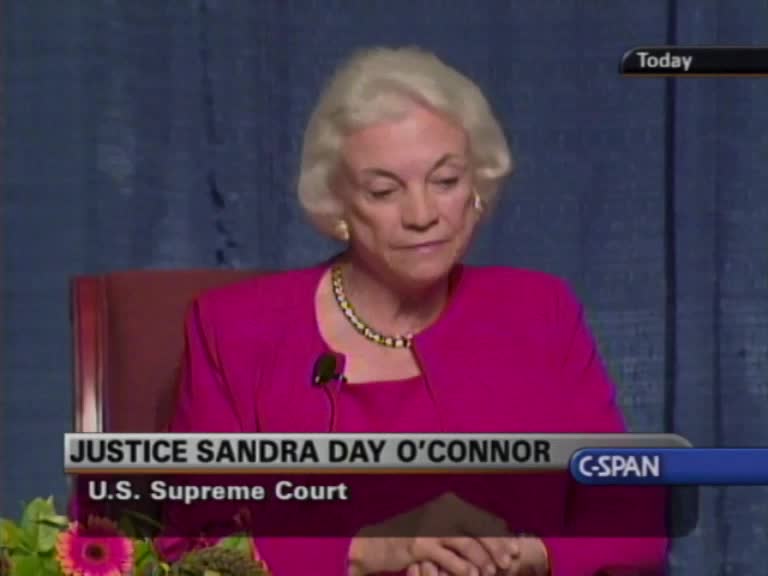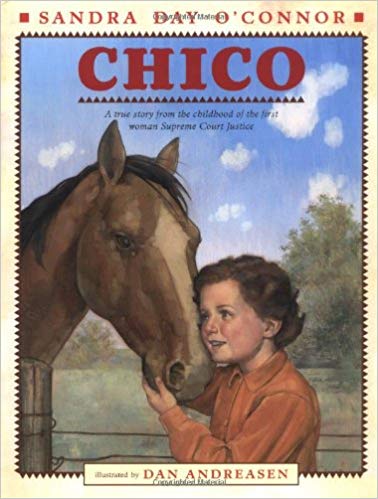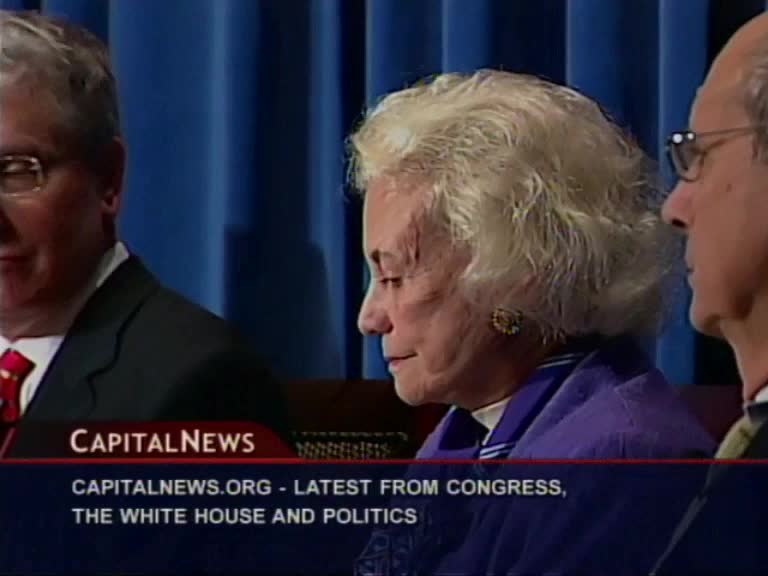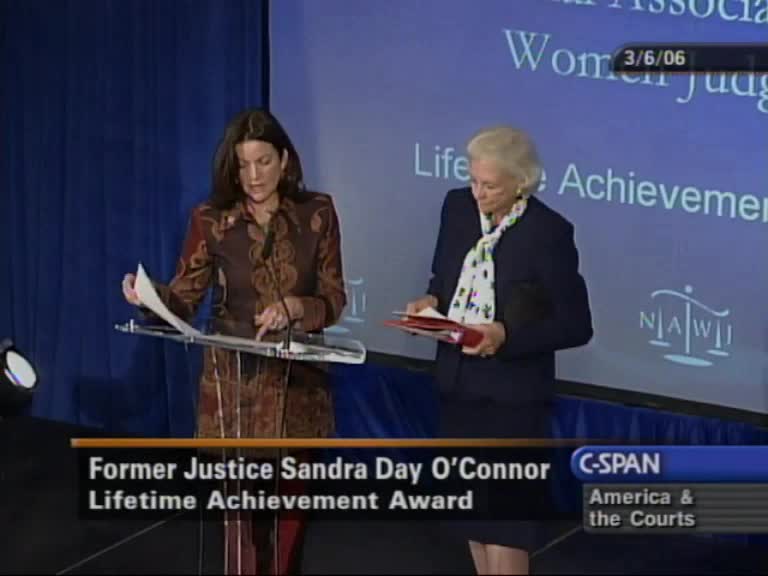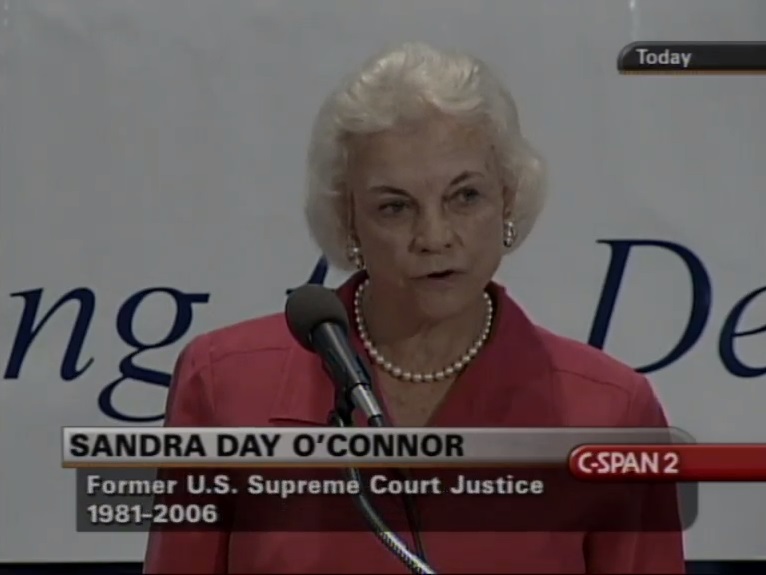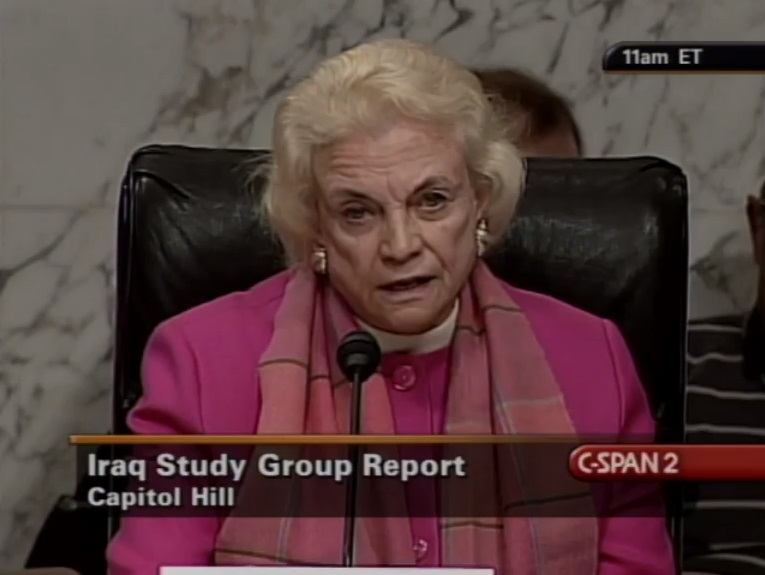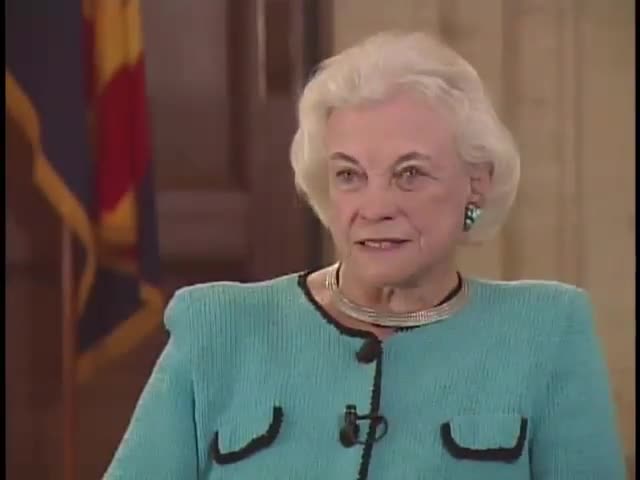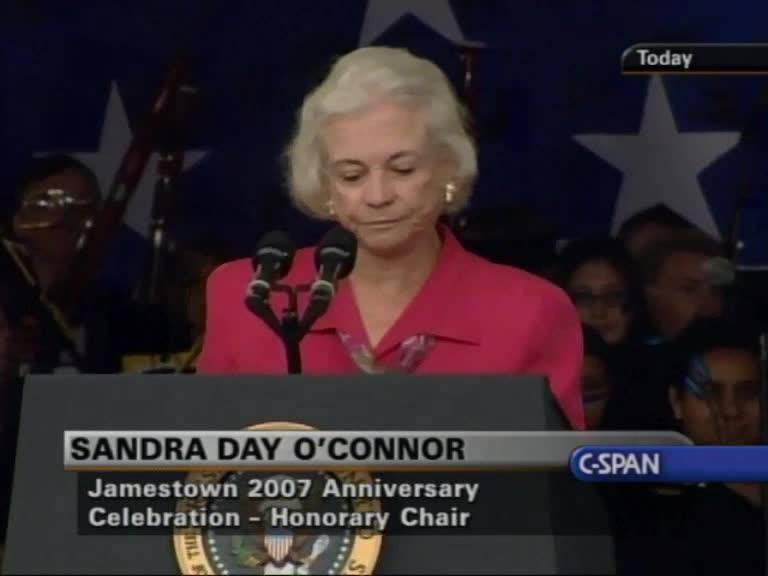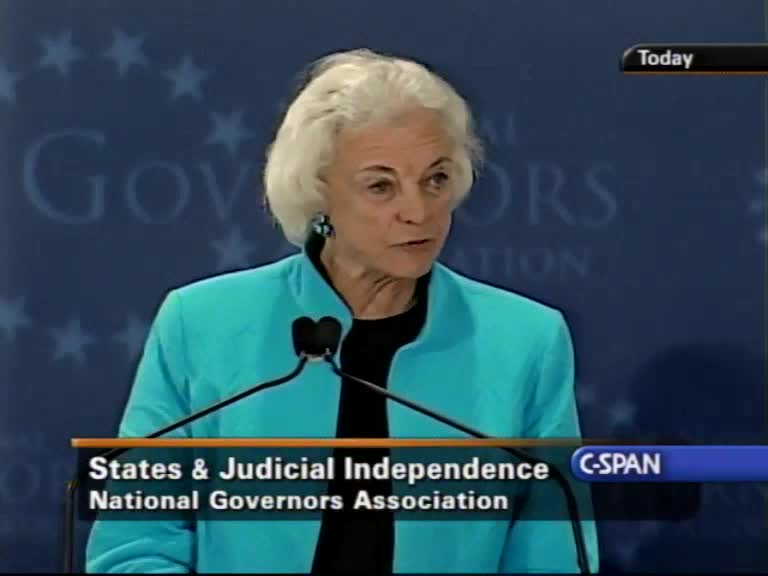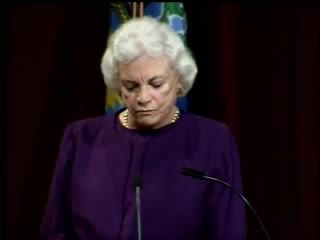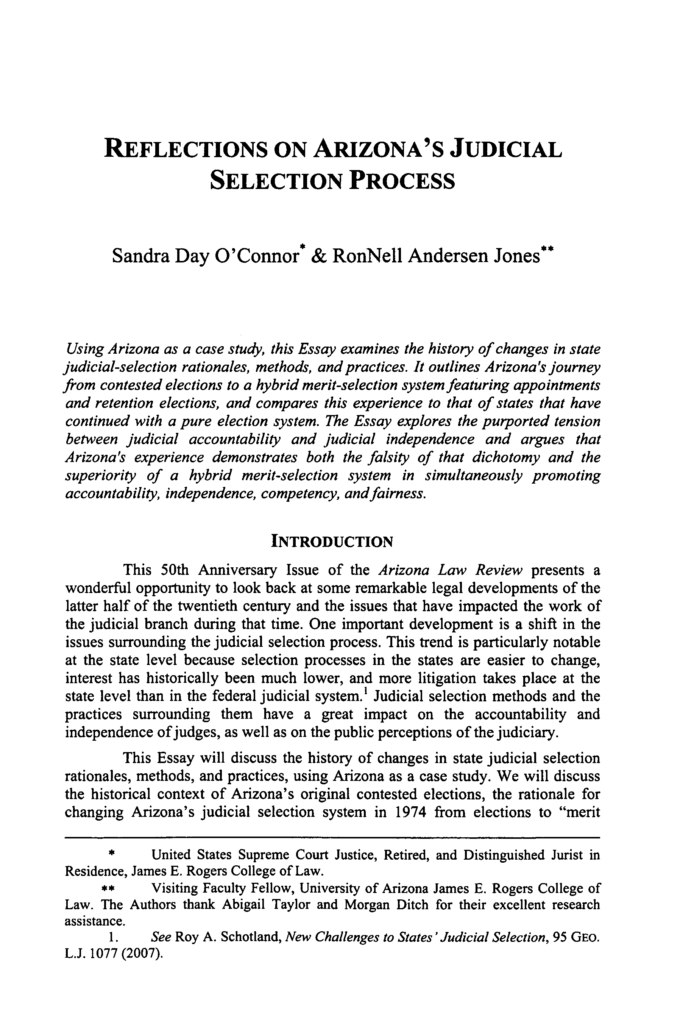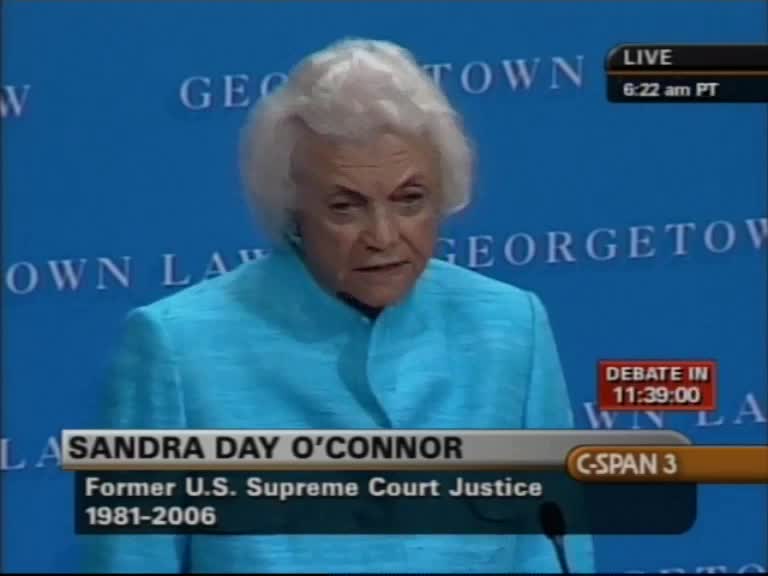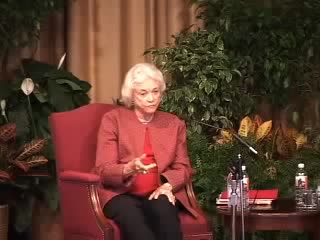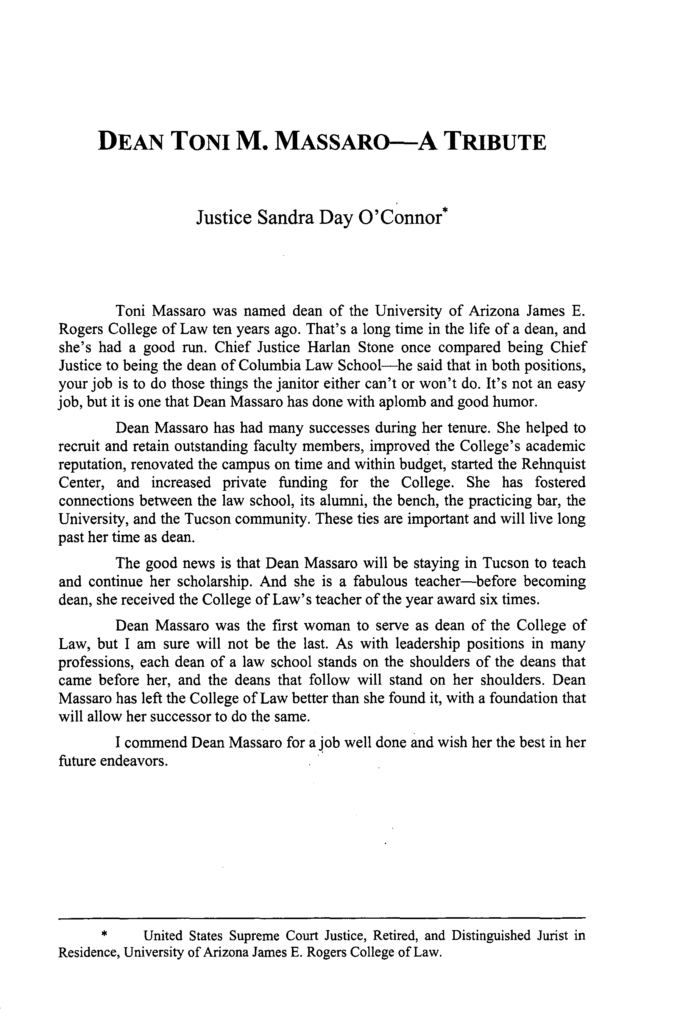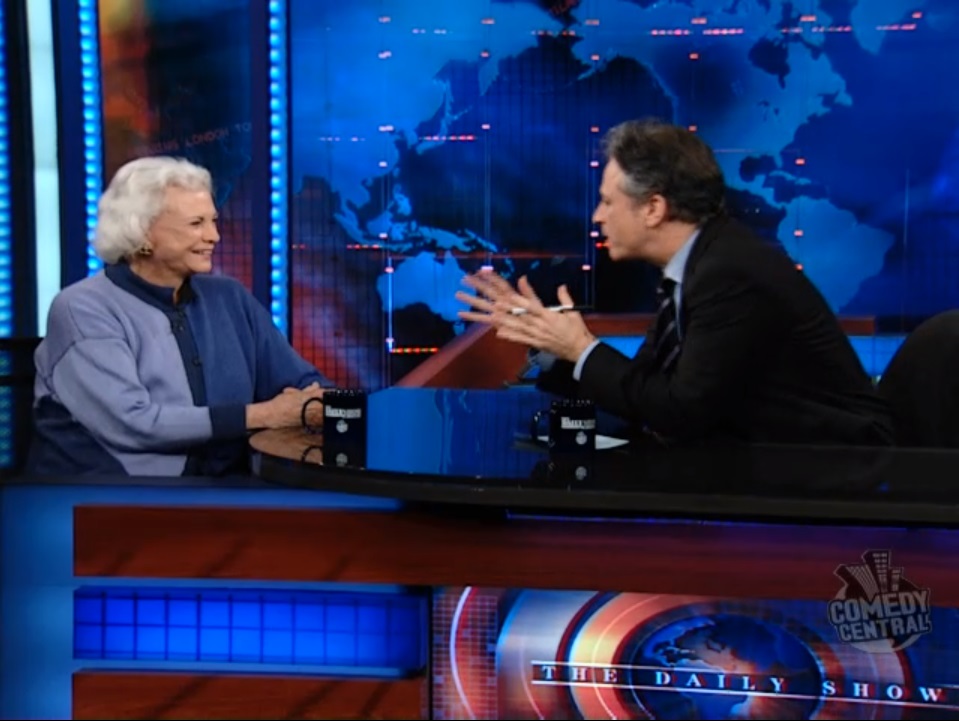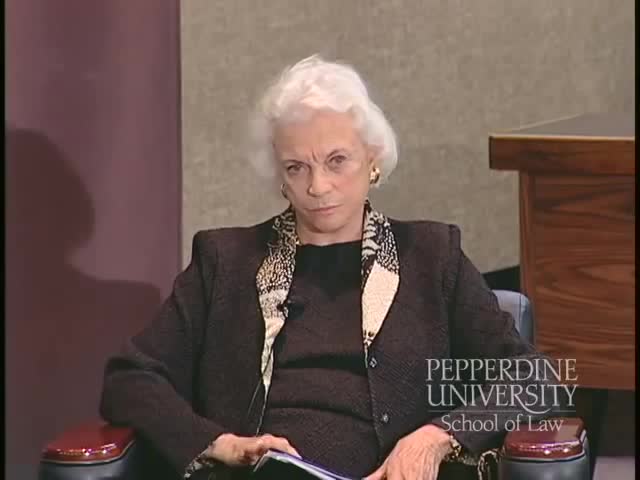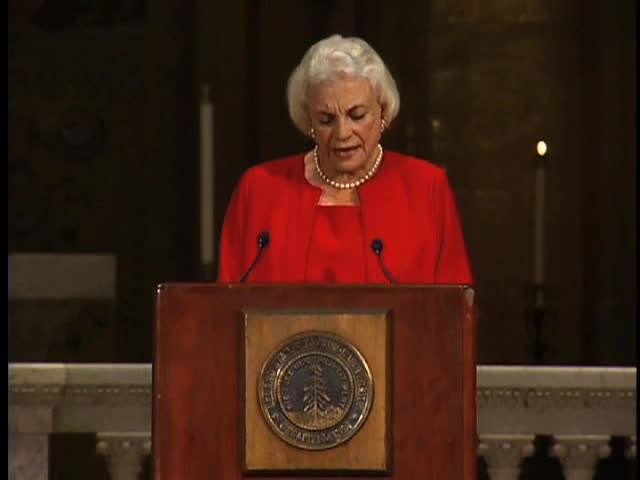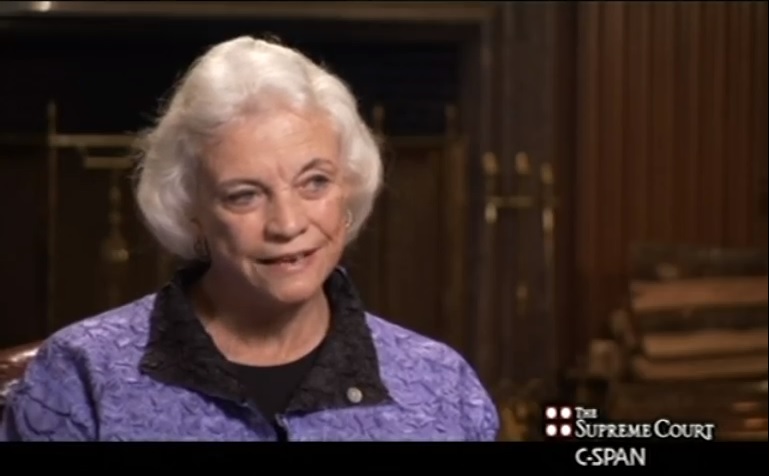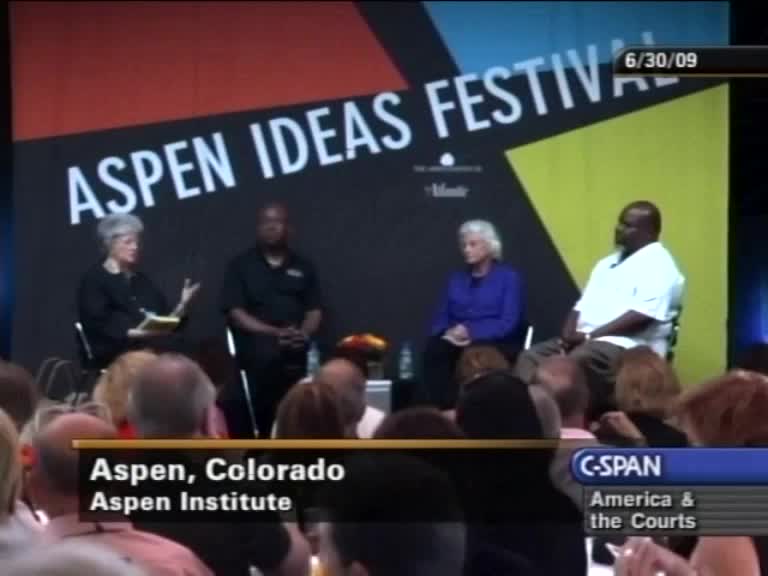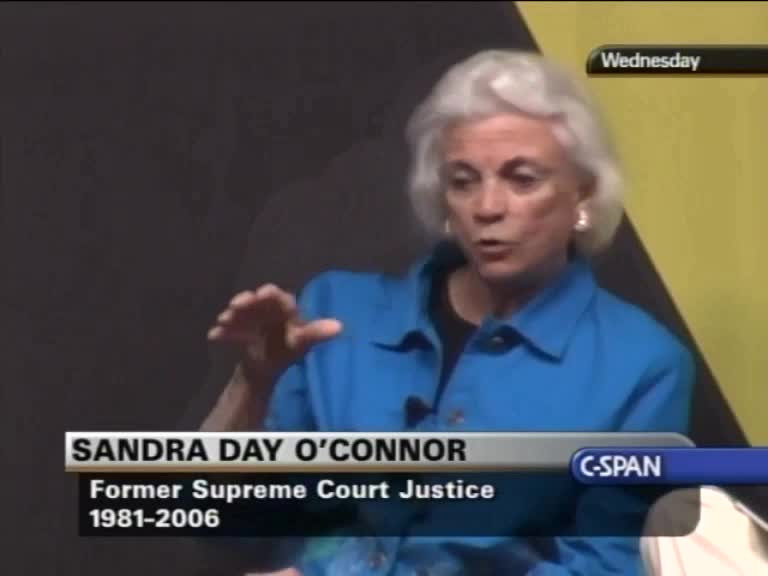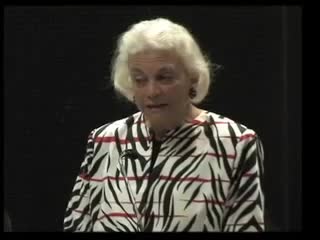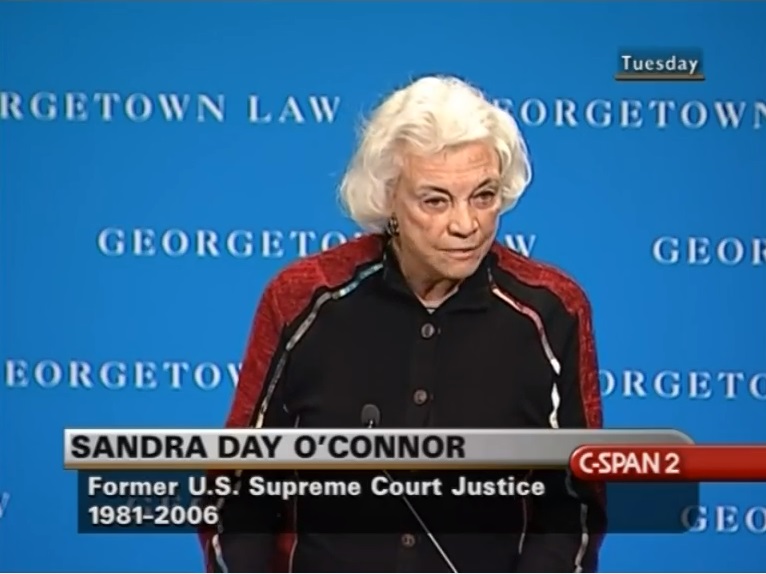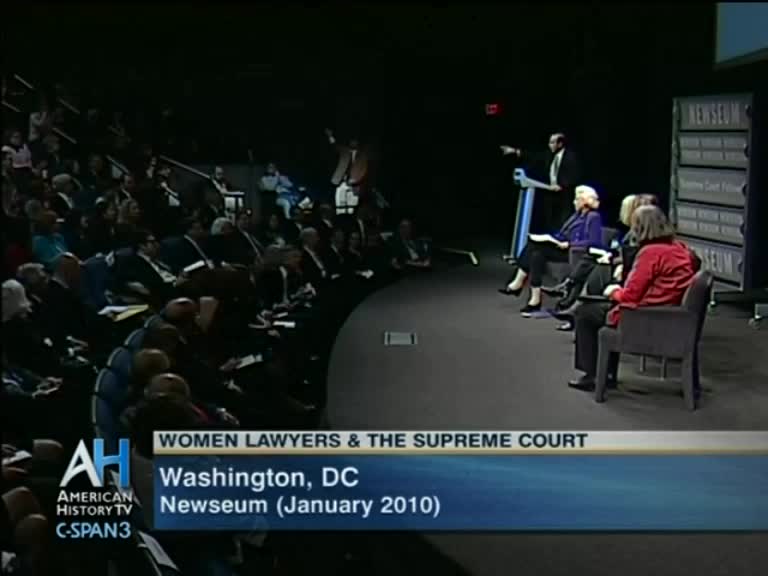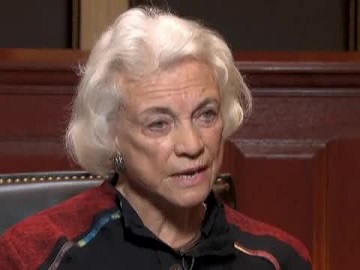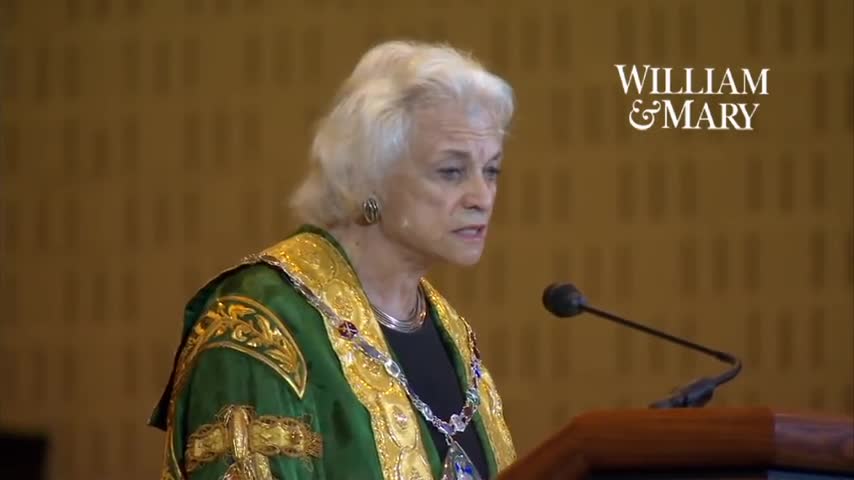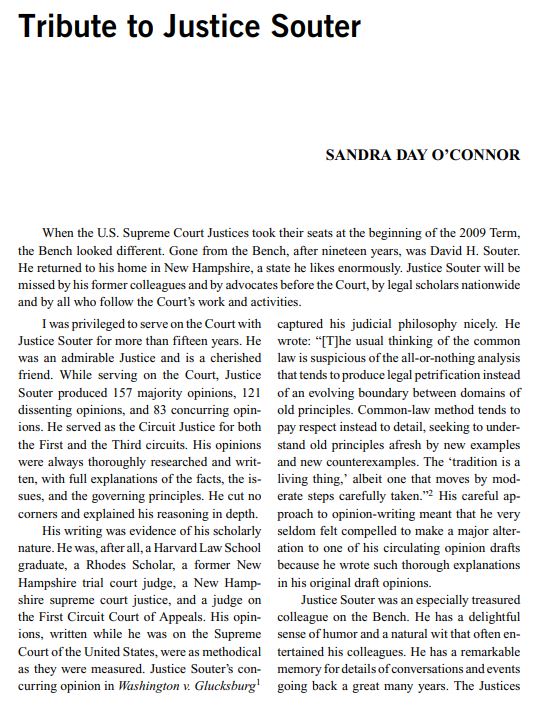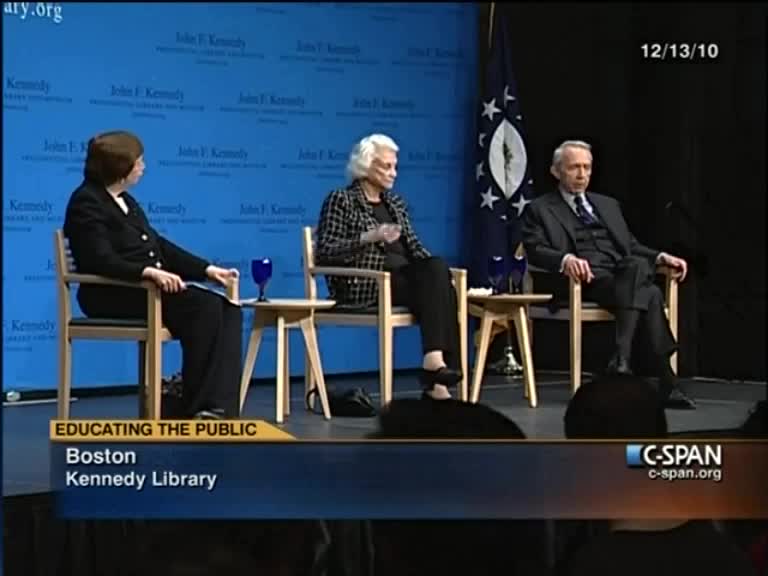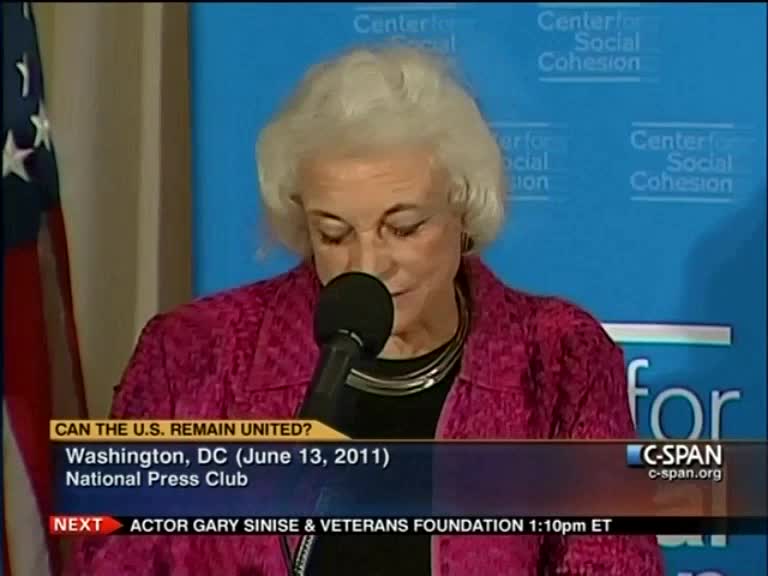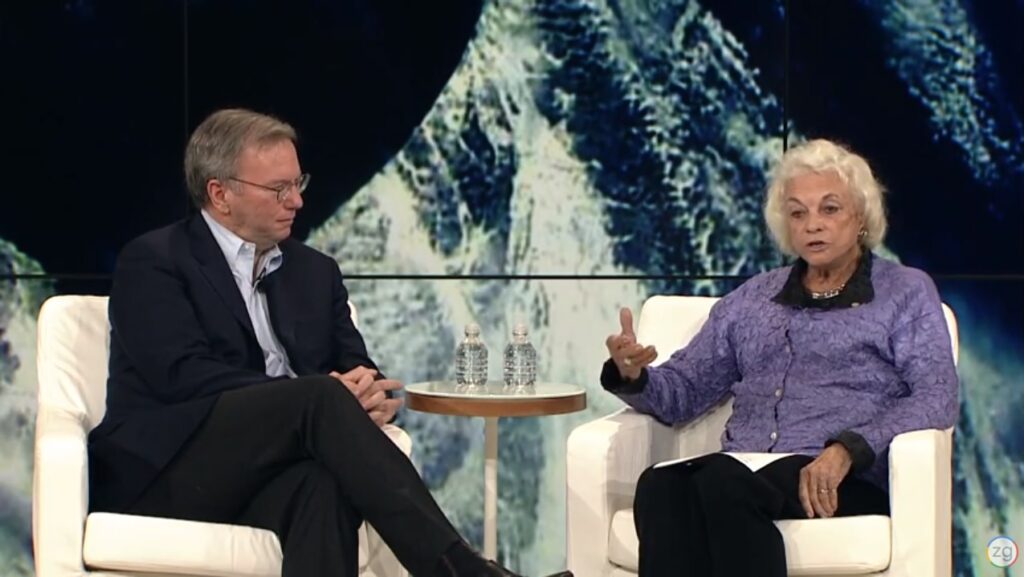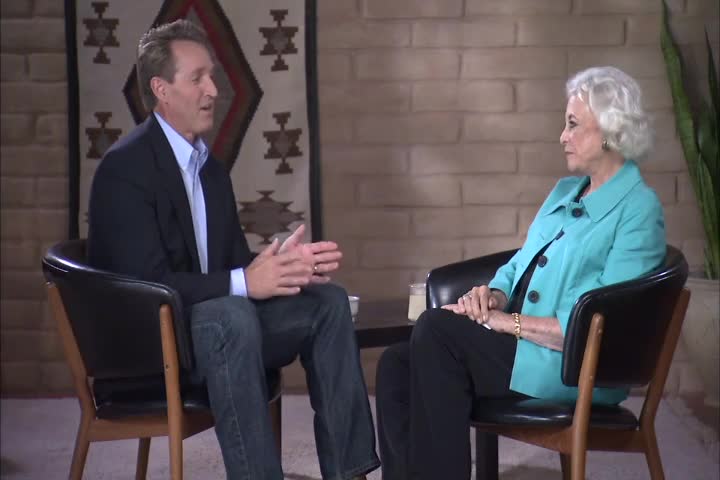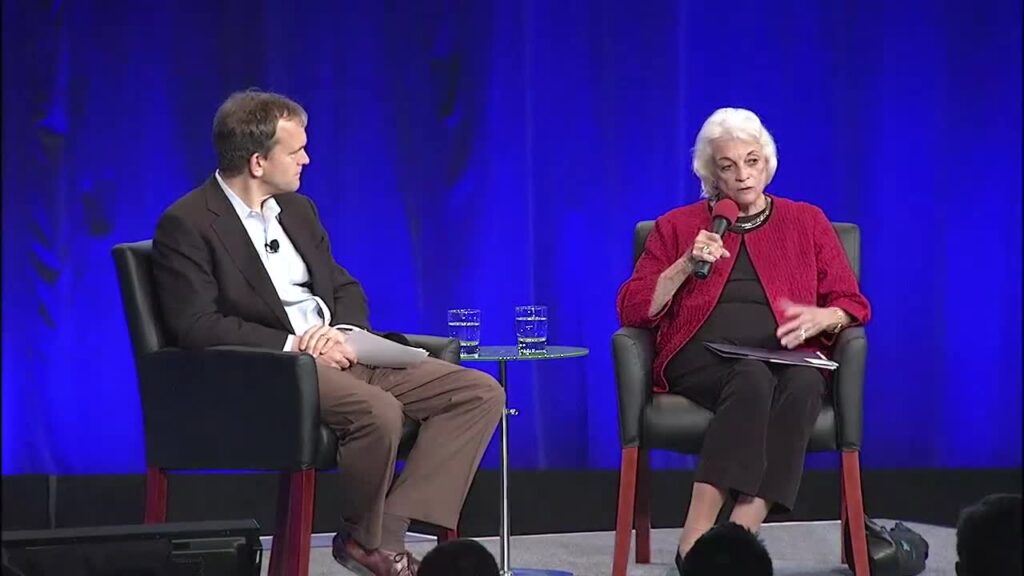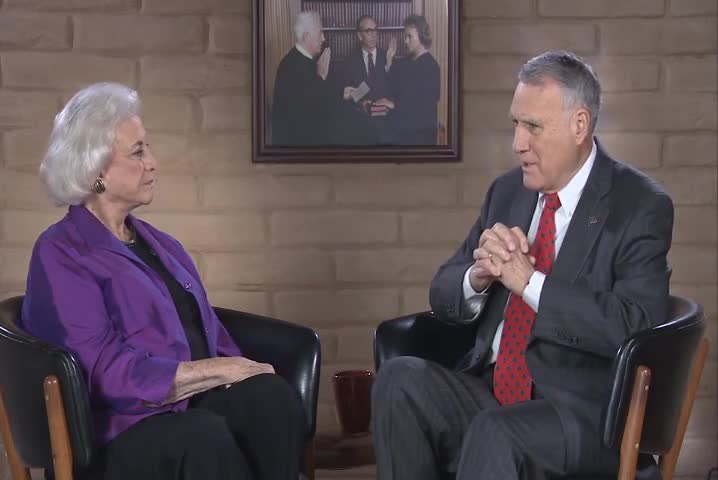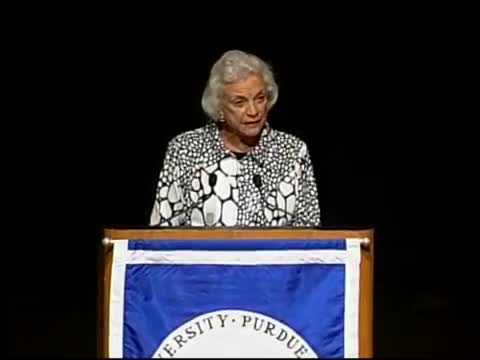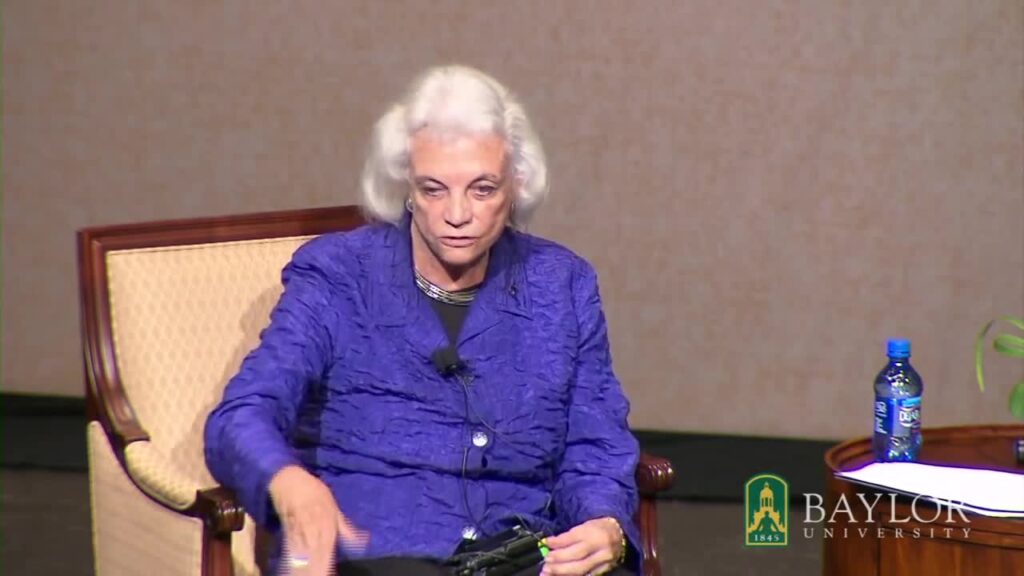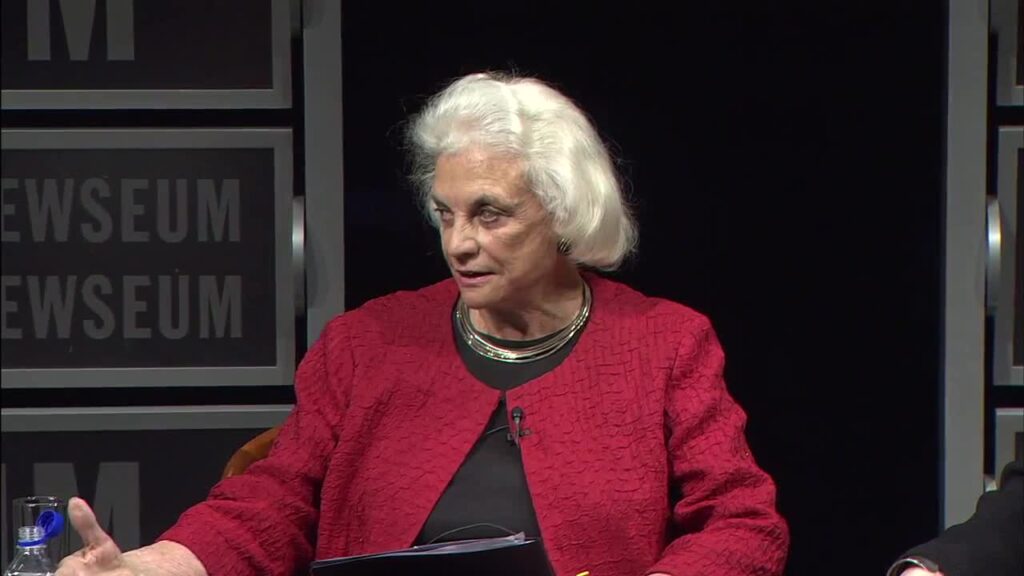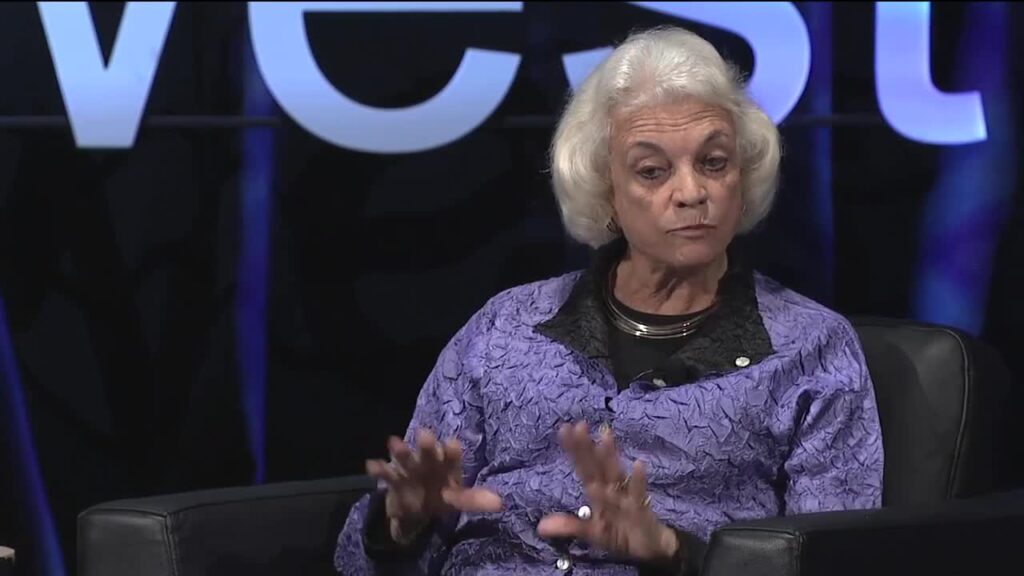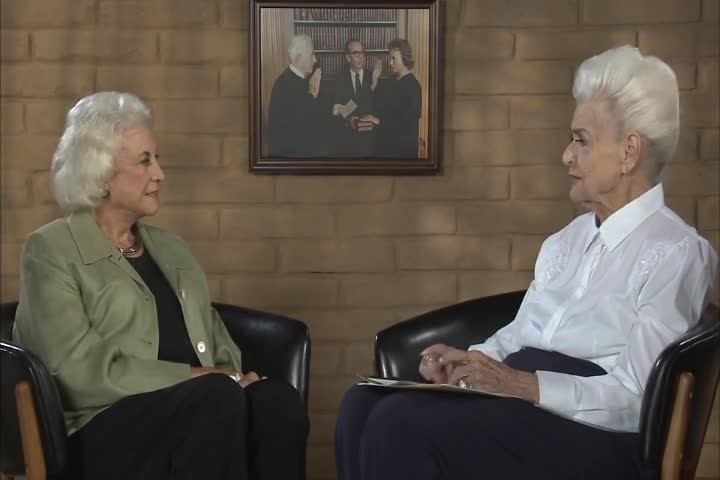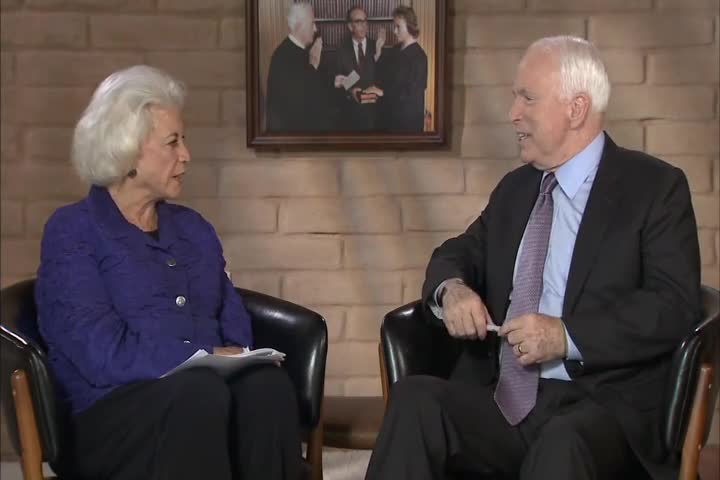Interviews, Speeches, Books and Writings
In this catalog, we invite you to explore Justice O'Connor's speeches, interviews, and writing throughout her career.
IT IS HARDLY A SECRET THAT MANY LAWYERS TODAY ARE dissatisfied with their professional lives. The pressures associated with the increasing commercialization of law practice have made lawyers, as a group, a profoundly unhappy lot. As one New York Times article concluded: “Job dissatisfaction among lawyers is widespread, profound and growing worse.”1
An examination of the research on lawyers’ overall well-being isdeeply troubling. Attorneys are more than three times as likely as nonlawyers to suffer from depression, and they are significantly more apt to develop a drug dependency, to get divorced, or to contemplate suicide. Lawyers suffer from stress-related diseases, such as ulcers, coronary artery disease, and hypertension, at rates well above average . Unsurprisingly, a recent RAND Institute study of lawyers in California found that they were “profoundly pessimistic about the state of the legal profession and its future” and that only half would choose to become lawyers if they had it to do over.2
This dissatisfaction with the present state of the legal profession is not limited to those within the legal community. Lawyers increasingly have been the subject of public derision. A lawyer in Texas recently filed a lawsuit claiming that he had been the victim of housing discrimination. Apparently, after several unpleasant experiences, the property company had adopted a policy of never selling new homes to attorneys. In economics, lawyers are typically described as creating deadweight
The Majesty of the Law: Reflections of a Supreme Court Justice
Acceptance speech for the Center for the Study of the Presidency’s Publius Award
Host If our guest of honor has often defied the odds, so too, she has resisted those who would put a label on her judicial philosophy for labels for cans, not coalition builders. for 23 years, she has demonstrated a rugged individualism reminiscent of the Arizona frontier of her girlhood belonging to no quick or ideological camp, as committed to the separation of powers as Publius as suspicious of judge made war as homes. officiating at a wedding in 1931. Justice Benjamin Cardozo’s spoke of quote, three grades mysteries in the lives of mortal beings, the mystery of birth at the beginning, the mystery of death at the end, and greater than either the mystery of love. Everything that is most precious in life is a form of love. Art is a form of love, if it be Noble. Labor is a form of love, if it be worthy. Thought is a form of love, it be inspired the art of jurisprudence, the labor of legal interpretation, the thought of a lifetime devoted to justice in the spirit of Cardozo, and the tradition of homes. It is no mystery by the Center for the Study of the presidency, should present the 2004 police award to Justice Sandra Day O’Connor, whose wall the wall is inseparable from her passion for justice. Congratulations. Sandra Day O’Connor That was quite an introduction. I wish the Cowboys could have heard that. Back at the lazy BR Richard Norton Smith is a wonderful historian and john and i were first privileged to meet him at the Ronald Reagan library. And it’s fun to hear him speak
Bridge to Public Service. It’s Up to Civil Servants to Tell Young People About the Great Opportunity to Change Lives and the Nation
Advice+Dissent
VIEWPOINT
Bridge to Public Service
It’s up to civil servants to tell young people about the great opportunity to change lives and the nation.
The following are excerpts from a speech by U.S. Supreme Court Justice Sandra Day O’Connor in her acceptance of the Elliot Richardson Prize from the Council for Excellence in Government in March.
Elliot Richardson, former U.S. attorney general, knew that ours is a nation built on pride in sacrifice and commitment to shared values-on a willingness of its cit izens to give of their time and energy for the good of the whole. He knew that there is no greater contribution than a life of dedication to public service. We are the nation that we are today because those bridge builders of the past gave of themselves in a way that really mattered.
To be sure, the work of bridge building can be as taxing as it is rewarding. These efforts can call for sacrifice-sometimes emotional, sometimes finan cial, sometimes personal. Those who choose the life of public service open themselves to public review.
Sometimes, I’m sorry to report, the nation that we aim to serve is not content with our efforts. But the ever-present understanding that you are a part of something bigger than yourself, and that your efforts are paving the way for those who will follow, makes a life of public service worth the bumps along the way. We cannot expect that a single gen eration of public servants will be able to bridge the gaps of inequality and injustice.
Interview on 60 Minutes
Justice O’Connor
produced by
Bill Owens
Catherine Herrick
Scott Pelley Of all you’ve heard about Ronald Reagan, there is someone you haven’t heard from. A person who has had almost as much impact on the history of our nation as the president himself. As a rule, Supreme Court justices don’t give many interviews. But Justice Sandra Day O’Connor sat down with us to talk about the man who made her the the first woman on the Supreme Court. Since that day in 1981, Justice O’Connor has become one of the most powerful women in America. In the years since Reagan left office, O’Connor has been the deciding vote, laying down the law of the land on abortion, affirmative action and the decision that made George Bush, President of the United States. We sat down with Justice O’Connor at the Supreme Court, an institution that had seen only men on the bench for nearly two centuries until Ronald Reagan changed it forever.
Sandra Day O’Connor It had an incredible ripple effect, of making opportunities become available for women. It was, it was just a remarkable transformation. And I really think he deserves an enormous amount of credit for making that happen in this country.
Ronald Reagan I will send to the Senate, the nomination of Judge Sandra Day O’Connor, of Arizona Court of Appeals, for confirmation as an associate justice of the United States Supreme Court.
Scott Pelley Just six months in office, President Reagan made his first appointment to the court. And other than his work to end
Remarks at funeral of President Ronald Reagan
This is a reading from a sermon delivered in 1630 by the Pilgrim leader, John Winthrop, who was aboard the ship The Arabella on his way from England to the Massachusetts Bay colony. The city on the hill passage was referenced by President Reagan in several notable speeches.
Now, the only way to provide for our posterity is to follow the council of Micah, to do justly, to walk humbly with our god. We must delight in each other. Make others’ conditions our own, rejoice together. Mourn together. Labor and suffer together. Always having before our eyes our commission and community in the work as members of the same body. The Lord will be our God, and delight to dwell among us as his own people. For we must consider that we shall be as a city upon a hill. The eyes of all people are upon us. So that if we shall deal falsely with our God in this work we have undertaken, and so cause him to withdraw his present help from us, we shall be made a story and a byword through the world.
Acceptance speech for the American Institute for Public Service’s Jefferson Award
Unknown Speaker Thank you very much. Now, Justice Sandra Day O’Connor. In June, she received the Jefferson award by the American Institute for Public Service. In 1972, Jacqueline Kennedy Onassis was one of three founders of the Institute, which called their Jefferson awards, a Nobel Prize for public and community service. Justice O’Connor was introduced by Charles Bartlett, the friend of the Kennedy family. Unknown Speaker I take great pleasure being given the honor of making this award, the greatest public service by an elected or appointed official, because in all years, we’ve been giving this award and are now quite a number of those years. I can never remember an award. When that was more appropriate than this one. I feel very strongly I come to this podium with great gusto. Because I think that Sandra Day O’Connor and her husband have brought to this town, a spirit that didn’t have before a liveliness, and a sense of participation, which is really invigorated this capital had been very important to us in worship. Unknown Speaker She gave us a little of her background and a very good sense that she’s actually romanticized her background in a marvelous book, which I hope all of you will read called lazy be lazy business story of her young life on this ranch, and beautiful part of the West. And in this book, we sort of feel that she got a special learning experience from a black cow hand name rosters. She describes him as a man without schooling, but a master on the range,
Commencement speech at Stanford University
President Hennessy, faculty, graduates and friends of Leland Stanford Jr. University: It is a great pleasure to be with you today at your commencement exercises. After all, it is a day of joy for everyone: You graduates have no more exams or classes to endure. And I might say, the faculty no longer has you to endure; you have fame and fortune ahead of you; your families and spouses and friends can look forward to seeing more of you; and your speaker is greatly honored by the privilege of being with you today as a speaker at your commencement.
I realize we have gathered here today to applaud those of you who will be receiving degrees. I suggest, however, that there are several heroes and heroines here today who should be recognized and with whom you graduates would like to share your glory. I refer, of course, to the parents, who have made two significant contributions to your presence today. First, they had the brains that you were lucky enough to inherit and, secondly, they probably provided at least some of the money you needed to sustain yourselves while you were here. I congratulate your parents, and I commend you graduates for your good judgment in selecting them.
A commencement speech is a particularly difficult assignment. The speaker is given no topic and is expected to be able to inspire all the graduates with a stirring speech about nothing at all. I suppose that’s why so many lawyers are asked to be commencement speakers; they’?re in the habit of talking extensively
Speech at the Chautaqua Institution
Sandra Day O’Connor
Thank you, Tom. And what a pleasure it is to be back here at Chautaqua. This such a special place, tucked under Lake Erie and along our border with Canada. The United States has only two next-door neighbors, Canada, and Mexico. I lived most of my life closer to the Mexican side of our border. I was born in El Paso, Texas and grew up on a ranch. And it was mostly in Arizona, and partly in New Mexico. And it’s a far cry from the shores of Lake Erie and Lake Chautaqua to that dry, semi-arid desert where I spent my early years.
When I first moved from Arizona to Washington, DC, John and I lived in an apartment in the Watergate that was kindly secured for us by my colleague Justice Lewis Powell as a temporary residence. We could look out our window, a view of a splendid statue of President Benito Juarez of Mexico, the former president. It’s inscribed with his words, “Respect for the rights of others is peace.” President Juarez has a place in Mexico’s pantheon of heroes, just as President Abraham Lincoln has in ours.
I thought of these two men as I reviewed one of the themes you’ve been considering this week, that human progress and human violence have been linked historical forces. In the 1860s, both these leaders, Juarez and Lincoln, led their countries out of violence and deadly conflict. Mexico faced a threat from outside in the form of the French intervention led by Napoleon [III]. The United States faced a threat from within. Now, having led their young
Speech at dedication of Eric E. Hotung Building at Georgetown University
DEDICATION OF THE ERIC E. HOTUNG INTERNATIONAL LAW CENTER BUILDING: KEYNOTE ADDRESS
SANDRA DAY O’CONNOR*
This is a very happy occasion indeed. And I’m glad that as a neighbor I was invited to come over and share this day with you. Georgetown University Law Center is our nation’s largest law school. It is consolidat ing its broad international law programs under one roof in the new Eric E. Hotung International Law building. This law school, which is located in our nation’s capital, already has one of the most comprehen sive international and comparative law programs in the world. It has at least twenty-two talented faculty members focused on these areas. Students from at least seventy-one countries are enrolled here in the international programs. Alumni of this law school live all across the globe, and the law school is already home to many diverse programs in the international area. In short, Georgetown University Law Center is now situated to be the leading global law center in this country and perhaps in the world. No wonder this is a special day.
International law has emerged in ways that affect all courts here and abroad. The reason is globalization. Its importance should not be underestimated. Thirty percent or more of our gross domestic product is internationally derived. We operate today under a very large array of international agreements, treaties, and organizations: the United Na tions Convention on Contracts for the International Sale of Goods, the North American
Speech on the relationship of international law to the U.S. Supreme Court at Georgetown University
Sandra Day O’Connor Thank you Dean Atlanta so much. Thank you. Thank you. His Eminence Cardinal McCarrick, President there, joi de Dana Lana cough and Dean Emeritus Judy or bream, and faculty, students and friends of Georgetown University Law Center. This is a very happy occasion indeed. And I’m glad that as a neighbor, I was invited to come over and share this day with you. Georgetown University Law Center is our nation’s largest law school. consolidating its broad and international law programs under one roof in the new Eric EO tongue, international law building the generosity of ambassador and Mrs. How tongue has made this possible. This law school, which is located in our nation’s capital, already has one of the most comprehensive international and comparative law programs in the world. It has at least 22 talented faculty members focused on these areas. Students from at least 71 countries are enrolled here in the International Programs. alumni of this law school live all across the globe. And as you’ve heard from the dean, the law school is already home to many many diverse programs in the international area, in short, Georgia. University Law Center is now situated to be the leading global Law Center in this country and perhaps in the world. No wonder this is a special day. International Law has emerged in ways that affect all courts here and abroad. The reason is globalization. It’s important should not be underestimated. 30% or more of our gross domestic product is internationa
Speech on jury service reform to the American Bar Association
Sandra Day O’Connor Thank you, President Gray. I appreciate that so much. And thanks for letting me be part of the effort today. I think my interest in this came about because of my years as a trial court judge and dealing with jurors in a great mini criminal as well as civil cases. And the jury system in this country is one of the most enduring aspects of our legal system as a whole. And the only time that most Americans other than lawyers and letting them see the inside of an actual courtroom is when they’re called to serve as jurors and juries have a proud history in this country as well as in England, where the jury as we know, developed today, Great Britain, Australia, Canada, New Zealand and the United States. Continue to use juries to hear evidence and determine facts. In a great many criminal cases. All only the United States and New Zealand continue to require use of juries in most civil cases. So it’s a shrinking universe out there. The Russian Federation is experimenting with the use of juries in serious criminal cases. And that seems to be expanding now to all parts of the Russian Federation. I think juries usually their do their jobs very well and occasionally show extraordinary courage in the face of hostile judges, perhaps, and try to deliver the verdict that justice demands, even if it might not be the one that the judge might want. I presided over many a trial and in all but two or three cases, I felt that the jury reached an entirely Appropriate verdict. And
Conversation with Justice Stephen Breyer
NARRATOR: In the summer of 1787, delegates to the Constitutional Convention gathered in Philadelphia to create a document that would establish the government of the United States. On September 17th, that landmark document, our Constitution, was signed. In commemoration of that day, students from several Philadelphia high schools were recently invited to the Supreme Court Building in Washington, DC to meet with Justices Sandra Day O’Connor and Stephen Breyer. The views of the students and the responses of the Justices provided a unique glimpse into the workings of America’s highest court and the document that shaped our history and guides our future. JUSTICE SANDRA DAY O’CONNOR: It’s nice to have you safely here and assembled. And are you all ready to start with some questions about our Constitution and our system? Who’s going to start off? STUDENT: How do you believe the Constitution should be taught in schools, especially with all the new resources that we have, and the fact that a lot of young people simply view the Constitution as something that was created 200-something years ago and is old and maybe out of date? JUSTICE O’CONNOR: I hope that the Constitution is something that every school in America will try to teach to young people. You don’t inherit it through the gene pool. Every generation has to learn about this, learn about the history. Why was it written, why do we have one? What does it provide? What are the benefits of having such a Constitution? Has it worked and
Conversation with students on the 4th Amendment
Unknown Speaker Good evening, Justice O’Connor. My name is Jordan speed and I’m from Wichita, Kansas. How does the Supreme Court decide when a search and seizure is unreasonable? And when it is reasonable? Sandra Day O’Connor Well, it’s a vague sort of a standard issue well know what’s reasonable depends very often on the circumstances in their particular case, the Supreme Court, in effect, has determined that if a search of a suspect is unreasonable under constitutional standards, then the evidence cannot be admitted against that person in any criminal proceeding against the person. Now, you know, many countries around the world don’t follow an exclusionary rule that’s called an exclusionary rule where you can exclude that evidence from any trial proceeding against the person that the state is trying to prosecute. And that’s rather a dramatic limitation on evidence that can be used by this state against someone. And many countries don’t do that. So great britain did, and the United States system map and I guess, Australia to a degree and other common law countries from the British system, but not everybody in the world. Thanks. That’s a good system. But we do and we have this exclusionary rule. So deciding whether a particular search or a seizure of some kind of evidence to use against someone in a criminal proceeding requires judges at the end of the day to make a determination whether that particular seizure or search was reasonable. Well, what’s reasonable? You have arguments
Music and the Law
[A]n overspeaking judge is no well-tuned cymbal.
-Francis Bacon, The Essay on Judicature
As you know, I’ve made a life in the law. And I’ve always loved music, from childhood on.
Lawyers feature in plenty of operas, of course. It starts with Moses, the first Lawgiver, in Rossini’s Mose and Arnold Schoenberg’s Moses und Aron. As expected, Moses generally comes off as an admirable character. But operatic evaluations of later lawyers are more critical. What we find in opera concerning lawyers after Moses is Puccini’s opera Gianni Schicchi about forging a will; a lawyer in Gershwin’s Porgy and Bess who sells Bess a divorce for a dollar-when he learns Bess was never actually married, he raises the price of the “divorce” to $1.50; we also see the lawyer in Strauss’ Die Fledermaus,who is so incompetent that he gets his client’s sentences increased.
The law’s presence is also palpable in the many operas which take place in jails. Jails must be irresistible to composers looking for a place to set a reflective aria-there is plenty of time to think in jail; there is nothing better to do; and the resonance is good. There are jail scenes in Faust, Don Carlo, and Tosca, for instance. Fideliot akes place entirely in jail, portraying a disguised woman’s successful attempt to save her wrongly imprisoned and soon-to-be-executed husband.
Gilbert and Sullivan also come through, as usual, with well placed pokes at the law. In Trial by fury,we meet a lonely Lord Chancellor whose job of approving
Acceptance speech for Harry S Truman Good Neighbor Award
Host Like President Truman, you can call her a liberal on some issues, and you can call her a conservative on others. However, it is clear that she has enabled the High Court to continue its role in the racial integration of our society, and the recognition of gender equality, and in protection of fundamental rights of expression, political participation, and due process of law. And therefore, Justice O’Connor, it is my pleasure to award you the 2005 Harry Truman Good Neighbor award. Sandra Day O’Connor Thank you so much indeed. This is an award that means a great deal to me. It’s a wonderful experience to be here as the recipient of the Harry Good Neighbor award. I have on my desk at the court, a little wooden piece that I bought at the Truman library, when I first visited it when Mr. celebre senior over here was was heading that and it says the buck stops here. And I have proudly had that at my desk as President Harry Truman developed it and had it and he is and President Truman. His reputation, and his legacy has only grown and strengthened with the passage of time. He liked to say he did his best and he did his best throughout his seven years as president from 1945 to 1952. He had to preside over an apprehensive a nation in the midst of a tumultuous world. Soon after, he took over as president World War Two and with the surrender of Germany and 45. the surrender of Japan later at that same year, when the Soviet Union began expanding communist regimes in Eastern Europe and
Speech at University of Houston Law Center
Excerpt quoted in “Afterword, Lazy B and the Nation’s Court: Pragmatism in the Service of Principle”:
[W]hen I entered law school, I didn’t even think about the future, whether I would want to practice law, and if I did, what the job opportunities would be. I just assumed I would be able to get a job, and that was a very naive position, looking back.
I finally called an undergraduate woman friend of mine at Stanford, whose father was a partner in a well-known, very large California law firm, headquartered in Los Angeles. I said, “Ask your father, if you would, if he could get me a job interview in the law firm.”
She did. And he did.
I made the trip to Los Angeles. I sat down with the law firm partner doing job interviews, and we chatted for a little while, and then he said, “Ms. Day, how do you type?”
I said, “Well, medium. I can get by but it’s not great.”
He said, “If you can demonstrate that you can type well enough, I might be able to get you a job in this firm as a legal secretary. But Ms. Day, we have never hired a woman as a lawyer here, and I don’t see the time when we will.”
So that was pretty much the situation.
Discussion with Justices Stephen Breyer and Antonin Scalia, moderated by Tim Russert, at the National Archives
MR. RUSSERT
Justice O’Connor, what should the American people know about our Constitution?
JUSTICE O’CONNOR
It’s unfortunate today, Tim, as you learned the other night, that young people in our country are growing up without any classes in civics, most of them without any knowledge or understanding of the Constitution or what’s in it and what it protects for our citizens.
JUSTICE O’CONNOR
And this is a major problem for our country, because you don’t inherit the knowledge through the gene pool. You have to learn it. Each generation has to learn it. And I think our goal ought to be, with young people, to give them the basics of what’s in that.
JUSTICE O’CONNOR
When I travel around the world, I guess the thing that I have come to respect the most is our Constitution and our legal system in this country, which gives you a certain feeling of confidence in this country that I don’t see elsewhere in the world.
MR. RUSSERT
Justice Scalia, what should the American people know about our Constitution?
JUSTICE SCALIA
I have a talk that I give to young people now and then about the Constitution. And it begins by trying to make them realize that it is something — a Constitution is of unique importance to Americans, for a number of reasons.
JUSTICE SCALIA
For one thing, Americans are an odd society. I’m not sure one like this ever existed before. Martin Diamond, the political scientist at Georgetown, since deceased, once observed that there is no word in a foreign language equivalent
Remarks on retirement from the Supreme Court at the Ninth Circuit Judicial Conference
Host And that is very high praise from him. Maybe growing up in the arid West now draws you to its waters. In appreciation for all that you have done for us and for the nation. We offer you a small token of appreciation and hope that the waters of the West will bring you back to us in the years to come. Justice O’Connor, thank you. And our, the gift is a fly box, inscribed, “Presented to Justice Sandra Day O’Connor, with appreciation, from your friends in the Ninth Circuit, July 21, 2005.”
Sandra Day O’Connor But what’s in it? Aha. All right. Now this looks like some serious fishing flies that I will very much enjoy trying to put to use with better luck than I had on Tuesday. And it’s a perfectly wonderful box and the flies look great. And I can’t imagine a better thing for you to leave with me to tempt me to come back many times. Ninth Circuit territory. Host Thank you judge–
Sandra Day O’Connor Now they’re gonna make me go to work. Host Thank you, Judge levy. Justice O’Connor. Your announcement took us all by surprise. Was it a difficult decision for you? Sandra Day O’Connor Yes. Yes. It’s been such a privilege to serve on the Supreme Court. When I was little, I always wanted to work. I wanted to work at some kind of work worth doing. Something where the individual effort put in would make a difference. And I was so privileged to serve 24 years at work that fitted that category very well. And then some. So I was lucky to have it. Host Judge Marilyn huff who was the former
Chico
Speech at Scottsdale Public Library on her book, Chico
Sandra Day O’Connor Thank you. That’s a great idea. I don’t know what could matter more in a community than the library. As all of you probably already know I grew up on a ranch in a very remote part of Arizona, half of the ranch was in New Mexico. The ranch straddled the state line. But the house was physically in Arizona. Most of the road from the highway was in New Mexico. But then it circled back into Arizona and that’s where I grew up. We were between Duncan, Arizona, and Lordsburg, New Mexico. About 30 miles from town either way. We didn’t go to town often in those days, and the ranch was sparse and dry. You know what the Arizona high desert country is like. And it’s full of everything that has teeth or claws or sharp spines — something to hurt you. And you learned early on to be a little bit careful about where you stepped and walked and rode and how you handled things. That can stand you in good stead through life, I think, is you have to walk through the bramble bushes of life. But my friends in my early years were books. I didn’t have siblings until about 10 years after my birth. And my friends were my parents and the cowboys who lived there at the ranch. And books. And I loved to read from early on. It meant so much to me. And that’s why I guess I have an affinity for libraries and why the invitation of the Scottsdale public library was a welcome one. I’ve not had a lot of time to write just for the sake of writing.
My bookshelves in my home are lined with something
We Need a Clear Set of Rules to Reaffirm Our Values as a Nation
It is a great privilege and honor to be at West Point today. The beauty and history of this institution make it one of our nation’s most treasured places. To be here and receive the Thayer Award, and to review a Parade is the experience of a lifetime. The previous recipients have most often been people with substantial military experience, such as General Colin Powell, Senator Robert Dole, and General Douglas MacArthur. By comparison, I am merely a sideline observer. Even Bob Hope – who came here to receive the award in 1968 – had more military experience than I do. As a result, West Point is making a bit of an exception in presenting the award to a mere Supreme Court Justice.
I understand that the Thayer award is supposed to be given to an “outstanding citizen of the United States whose service, accomplishments, and stature exemplify personal devotion to the ideals expressed in the West Point motto, “DUTY, HONOR, COUNTRY.” That is a wonderful and grand motto. I have been tested a bit lately on the “duty” front: As many of you know, I did my best to retire from the Supreme Court this summer. The President nominated Judge John Roberts to be my successor, and I assumed I might be trout fishing in Montana or seeing my grandchildren in Arizona on the first Monday of October, when the new term started. Then the nation learned of the sudden death of our Chief Justice, William Rehnquist. He served on the Supreme Court for 33 years in all and was a great Chief Justice. He was also a
Remarks to the American Bar Association on the global rule of law movement
Sandra Day O’Connor
I want to thank the American Bar Association for all of the important work that it does to promote the rule of law and for convening this really important meeting to advance that cause. Now why? It’s because the rule of law offers a basic guarantee of good government, of fair treatment and accountability. And these are the building blocks for a society that can effectively protect its citizens and help them reach their own potential. The discussions held here have underscored the urgency of promoting the rule of law, not just to realize the human potential, but also as part of an effective strategy to address some pressing social problems.
We have some critical challenges: combating terrorism, combating corruption, poverty, and the threat of pandemics. And all of these would be alleviated, in part, by a rule of law movement. But this can’t be a project of just one organization, or one profession, or one country. I think each of us has a stake in the rule of law, and we have to work together toward the goal. No one country has all the answers, certainly our country does not. You’ve learned that in the United States, there are current threats to the independence of our judiciary and the rule of law. And I think there are problems in most countries in that regard. So one of the important contributions that this gathering has made has been bringing together a wide range of different stakeholders in the concept of the rule of law, from the private sector, from
Panel discussion on the role of the judiciary with the American Bar Association
Unknown Speaker Their stories of world war two Korea and Vietnam. Three members Unknown Speaker of the Supreme Court talked about the role of the judiciary at this event hosted by the American Bar Association. justices Stephen Brier, Unknown Speaker Sandra Day O’Connor and Anthony Kennedy spoke for just under an hour and a half. Unknown Speaker As we get in this part of the program, we’re going to vary from oral questions to written questions. So I, as you Stephen Breyer hear the Unknown Speaker presentation and you have your questions, please write them down. And then when we asked for them, you can put your hand up and we’ll pick them up. Justice Kennedy will need to leave slightly early. But and we will miss him but we will continue to there’s the normal time at this time. You already know my great co our president American Bar and he will now introduced this program. Unknown Speaker Good afternoon, everyone. Unknown Speaker We are all in for a treat Unknown Speaker during the next 90 minutes. And while we’re doing the technology here, let me offer it an observation and a question of all of you. The observation is this, I have to leave immediately after this panel to go to the airport. Because tomorrow morning at 8am, I’ll be in Seattle, Washington addressing the judiciary on the way judges are selected in the state of Washington. So I won’t have a chance to speak with you after I leave. My question to you is this after I pay respects to the people who have made this
Remembering Rehnquist
Remembering Rehnquist
SANDRA DAY O’CONNOR
William Hubbs Rehnquist spent the last thirty-three years of his life as a member of the U.S. Supreme Court, fifteen as an Associate Justice and eighteen as Chief Justice. I met Bill when I was a freshman at Stanford in 1946. He was attending Stanford and working part time as a “hasher” at my dormitory during the evening meal. He amazed all of the young women by carrying such heavy loads of dishes on his tray. Perhaps that is how he learned to carry all those heavy loads in all of the years that followed. He was tall and good-looking, and he had a sharp sense of humor.
In 1950—after he had graduated Phi Beta Kappa from Stanford with a B.A. and an M.A., and received another M.A. from Harvard—he and I enrolled at Stanford Law School. He really put the “Bill” into the “G.I. Bill”: he had attained the rank of sergeant and had served in the Army Air Corps as a weather observer in the United States and North Africa. Like many of my classmates who had served in the war, he was serious about his studies and eager to get his LL.B. and practice law. Bill was clearly the brightest in our class, always prepared and willing to express his views when asked, and his conservative views were backed up by brilliant analysis. We also enjoyed bridge games, charades, and occasional movies. Little did either of us expect to serve on the Supreme Court one day.
Our class was very excited when Bill got a Supreme Court clerkship with Justice Robert
Acceptance speech for the National Association of Women Judges’ Lifetime Achievement Award
Sandra Day O’Connor Well, President Ruiz that was quite a presentation indeed. And accolades, compliments from one’s peers, my fellow women judges are the ones that are most appreciated, as you know. And I’m just overwhelmed by all the kindness that you have shown tonight in hosting this great reception and expressing in such generous terms. Your appreciation, I remember so well, when Joan Dempsey climb, then a judge in California decided to get this organization going. And I promptly joined, not having any idea at the time that it would grow as it has, perhaps it would not have done so had not President Ronald Reagan decided, I thought rather courageously to put a woman on the Supreme Court. He campaigned, as you pointed out, saying he wouldn’t do it. And his action opens so many doors for women not only in this country but around the world. I remember so well, the day he called me and after I left the interview in his office, I think he did talk to some other people and I left that office and flew back to Arizona that day, and breathed a big sigh of relief. I was interested to obscene the Oval Office and to met with the president and some of his advisors and I said to myself, thank goodness, I don’t have to go to Washington and do that job. I really did not imagine that I would be at I mean, my classmate at Stanford, William Rehnquist, was already a member of the court. And I couldn’t imagine that that would happen. But it did. And I had to take a lot of deep breaths to decide.
Speech at the National Women’s History Month Celebration
MS. KAREN P. TANDY: Good morning. I am the administrator of the Drug Enforcement Administration and it is my honor thank you for being here today and to ask you to please join me in welcoming the Attorney General and Justice O’Connor for today’s event.
I would like to point out to some special people with us this morning, first, Mr. John O’Connor, the husband of Justice O’Connor, and Mrs. Rebecca Gonzales, the wife of the Attorney General.
I ask you now to please rise for the presentation of the Flag by Girl Scout Brownie Troop Number 470 and for the singing of the National Anthem by Ms. Anamer Castrello.
You may be seated. Please join me in thanking these very special young Trail Blazers for the future of women, the Brownie Girl Scouts.
And, Ms. Castrello, thank you. Thank you for that stirring rendition of the National Anthem.
Welcome to all of you today. When I think about our theme, “Women: The Builders of Communities and Dreams,” I cannot help but think about some of those little known women from the American Revolutionary period who made it possible for us to have our communities today because of what they did back then in building our great nation.
The demure hoop-skirted women of the 1700s were the same women who tricked the enemy. The Red Coats met their match when they invaded the home of Mrs. Murray, a woman known only to us as Mrs. Murray, for Mrs. Murray plied the British generals with enough liquor that the small band of American soldiers were able to sneak
“Response” (The Legacy of Chief Justice Rehnquist and Justice O’Connor)
It is not fair to have to follow a speaker as eloquent as Justice Kennedy. And I am not going to try to bend your ears for long. I am very touched by his comments. It was wonderful that you had a chance to hear him talk about our former colleague, William Rehnquist, as well as some remarks about me.
Our Stanford alums have lost two members of the Court who belong to Stanford and who belong to the West. We used to take a lot of pride in how we just needed one more to have a majority on the Court from Stanford. Now I guess the chances of a Court majority from Stanford are not so good. When I started at Stanford Law School back in the Dark Ages, the Law School was in the inner quad. And it was a funny little part of the inner quad–the law library was quite old and musty and we had an owl that lived in the stacks. I used to do homework in that library, and I’d always watch and see where the owl was sitting that day.
Bill Rehnquist was my classmate, and I often sat next to him. I would look over and see what kind of notes he took. I took copious notes. I tried to write down everything the professors had to say. But he ended up each hour with a perfect outline, and he just captured exactly the essence of what was presented. He did a great job. He could have made a fortune on those notes had he chosen to do so.
The Law School then moved into nicer quarters. It was on the outer quad, over near the Business School facing Palm Drive. We thought we were in high cotton when we got there.
“Not By Math Alone”
March 25, 2006
Fierce global competition prompted President Bush to use the State of the Union address to call for better math and science education, where there’s evidence that many schools are falling short.
We should be equally troubled by another shortcoming in American schools: Most young people today simply do not have an adequate understanding of how our government and political system work, and they are thus not well prepared to participate as citizens.
This country has long exemplified democratic practice to the rest of the world. With the attention we are paying to advancing democracy abroad, we ought not neglect it at home.
Two-thirds of 12th-graders scored below “proficient” on the last national civics assessment in 1998, and only 9 percent could list two ways a democracy benefits from citizen participation. Yes, young people remain highly patriotic, and many volunteer in their communities. But most are largely disconnected from current events and issues.
A healthy democracy depends on the participation of citizens, and that participation is learned behavior; it doesn’t just happen. As the 2003 report “The Civic Mission of Schools” noted: “Individuals do not automatically become free and responsible citizens, but must be educated for citizenship.” That means civic learning — educating students for democracy — needs to be on par with other academic subjects.
This is not a new idea. Our first public schools saw education for citizenship as a core part of their
Speech to the Campaign for the Civic Mission of Schools
Host So join me in welcoming the honorable Sandra Day O’Connor. Sandra Day O’Connor Come on. No, no. No. I agreed to be part of this Voluntary Group, as a part of the Advisory Council for this effort, because of my absolute conviction that we have to educate all of our young people on how democracies function. What do we mean when we talk about rule of law? How do citizens have the capacity? And do they have a duty to protect? The pay and how to do it? If we don’t do this, it won’t take more than three or four years before we will have created such a gap in the capacity and willingness of our citizens to be good citizens, that our country will take a major decline. There is no question that we have to do precisely the activity that this effort is all about. We have to teach every succeeding generation of young people what it is ourselves. system of government consists of our works, how they can be part of it, and why they should be part of it.
Now, it isn’t easy to do this. My co-honorary chair here, Governor Romer, runs about the second largest school district in the country. And he knows exactly what the problems are. But you see, this knowledge about how we function in this country isn’t handed down through the gene pool. Every generation has to learn it. And we who are older have to be responsible for teaching. I mean, it’s that simple. But you have to teach it in ways that will engage the students. We have maybe a more sophisticated student group and in my day, where
Interview with Diane Rehm, NPR
Diane Rehm Thanks for joining us, I’m Diane Rehm. when ronald reagan nominated the first woman to the Supreme Court 25 years ago, few imagine that Sandra Day O’Connor would emerge as its most influential member since retiring in January. Justice O’Connor is spoken out forcefully and defensive the courts him as huge digital decisions may anger politicians, but retaliatory threats against judges threatened democracy itself. Joining me in this studio to talk about the role of the courts and her service on the nation’s highest court Justice Sandra Day O’Connor, and throughout the hour, we’ll take your calls your comments, questions 800 for 338850 Send your email to Dr. show@wamu.org. Welcome to you just as how con are so good to see you. Sandra Day O’Connor Thank you, Diane. I’m glad to be here and to see you Thank you. Diane Rehm Tell me how concerned you are about the independent The judicial branch of our government, Sandra Day O’Connor I am concerned. I’ve lived a pretty long time now. And in my lifetime, I don’t believe I’ve seen as many complaints by members of Congress, by state legislators, by other officials, and even by the public, about judges. were hearing statements rather frequently, I think, complaining that judges are activists, godless, secular humanists trying to impose some new regime on the nation. And I just don’t see it that way. I understand that. Sometimes judges have to resolve very controversial issues. Sometimes in cases where the good arguments can
Fair and Independent Courts
Sandra Day O’Connor, a Fellow of the American Academy since 2007, served as an Associate Justice of the U.S. Supreme Court from 1981 until her retirement in 2006. The first woman to serve on the Court, she is the author of ”The Majesty of the Law: Reflections of a Supreme Court Justice” (with Craig Joyce, 2003 ) and ” Lazy B: Growing Up on a Cattle Ranch in the American South west” (with H. Alan Day, 2002).
© 2008 by the American Academy of Arts & Sciences
More than one hundred years ago Roscoe Pound delivered an important address to the American Bar Association called “The Causes of Popular Dis satisfaction with the Administration of Justice.”1 In that address, Pound, who would later become dean of the Harvard Law School, warned his audience, “[W]e must not be deceived… into overlook ing or underrating the real and serious dissatisfaction with courts and lack of respect for the law, which exists in the United States today.”2 I believe that Pound’s words apply with at least equal force today as they did in 1906.
The United States has promoted the notion of the rule of law as a means for helping to ensure peace and democracy around the world. In our work with emerging nations and with the breakup of the Soviet Union, we have continual ly advocated the importance of the rule of law. One necessary component to achieving the rule of law, of course, is a fair, impartial, and independent judiciary. The United States ‘s federal judiciary has been the envy of the world for many
“The Threat to Judicial Independence”
In November, South Dakotans will vote on a state constitutional amendment being advocated by a national group called “JAIL 4 Judges.” If the amendment passes, it would eliminate judicial immunity, and enable a special grand jury to censure judges for their official legal determinations. Although the amendment’s supporters claim they seek a “judicial accountability initiative law” (JAIL), they aspire to something far more sinister — judicial intimidation. Indeed, the national Web site of JAIL 4 Judges boasts with striking candor that the organization “has that intimidation factor flowing through the judicial system.”
It is tempting to dismiss this proposed amendment as merely an isolated bout of anti-judge angst. But while the JAIL 4 Judges initiative is unusually venomous, it is far from alone in expressing skepticism of the judiciary. In addition to South Dakota, this election cycle has witnessed efforts in at least three other states that are designed to rein in judges who have supposedly “run amok.”
Not to be completely outdone, Congress also has engaged in recent efforts to police the judiciary. Seeking to constrain the legal sources that are available to judges, some members of Congress have advocated measures that would forbid judges from citing foreign law when they are interpreting the Constitution. In addition, bills have been introduced in both houses of Congress supporting the creation of an inspector general to investigate and monitor the federal bench. Finally,
Speech on judicial independence at Georgetown University
Sandra Day O’Connor I’m going to get you on my next book tour if I ever have one. That’s fun. And thank you my wonderful former colleagues for showing up today. Justice Thomas Justice Souter, and I think Justice Alito is going to join us if he’s not already here. And thank every one of you for coming and participating in this conference. I think you’ve already heard from President to Julia, and Michael trainer, why we’re doing this.
And it’s already been mentioned that 100 years ago this year, Roscoe pound, who went on to become dean of the Harvard Law School, gave his well publicized address to the American Bar, call the causes of popular dissatisfaction with the administration of justice. And he warned in that speech that we must not be deceived into overlooking or underwriting the real and serious dissatisfaction with courts and lack of respect for the law, which exists in the United States today. And I think that statement holds true today as well. We have promoted in this country, the notion of the rule of law as a means for helping ensure peace around the world, in our work with the emerging nations with the breakup of the Soviet Union, and in other countries we have actively urged upon every nation that we be concerned with the rule of law and The key component to that is a fair, impartial and independent judiciary. For a long time, I think the federal judiciary in this country has certainly been noted in other countries and admired and many would want to copy it. I
Interview on “Hardball with Chris Matthews”
Remarks on the release of the Iraq Study Group Report
Sandra Day O’Connor I would be willing to add a comment about what Leon Panetta has just expressed so well. We’ve said in the report that we agree with the goal of U.S. policy in Iraq, as stated by the president: an Iraq that can govern itself, sustain itself and defend itself. And to do that, we’ve made these various recommendations on a consensus basis.
It’s my belief that if a large segment of our country gets behind that, on a consensus basis, that it’s very likely we can move forward and make some progress toward that statement of goals.
And this is not an ongoing commission. It really is out of our hands, having done what we did. It’s up to you, frankly. You are the people who speak to the American people. You’re there interpreting this and talking to America. And I hope that the American people will feel that if they are behind something in broad terms, that we’ll be better off. I think we will, and I hope, in general, others think so, too.
Interview with Arizona Capitol Television
Unknown Speaker Thank you for joining us today I’m just honored to be sitting across from you interviewing you and to have you here with us. Sandra Day O’Connor You’re welcome. And I’m glad to be here. Unknown Speaker Most people already know that you paved the way for women by being the first woman on point to the US Supreme Court. But I think fewer people know that you also pave the way in Arizona by being the first woman, majority leader in any state senate. Right. In fact, there Sandra Day O’Connor there had been no woman, legislative leader in any post in across the country. And it was such a surprise to me when my colleagues voted in a closed ballot to select me as the majority leader. I was shocked. But it was a wonderful experience. I learned a lot. Unknown Speaker What would you say were some of the challenges that might have came along Sandra Day O’Connor with? Well, the challenges in those days was that it’s a small state Senate, they’re 32 members. And I was a Republican, and the republicans held a majority of one. So it was very challenging to work with that very narrow majority in the Republican Party. And what it meant was that for many pieces of legislation, in order to pass anything, we had to have support from the other side of the aisle. Luckily, it was a time in Arizona, when I don’t think the political feelings were as partisan as they seem to be at times today. And there were many says, When legislators from both parties would work together on legislation
Speech at 400th anniversary celebration of Jamestown, Virginia
Sandra Day O’Connor Thank you, Governor Page. Thank you. Thank you. Sandra Day O’Connor This is a great occasion. The volunteers, some 2000 of them, have been working for more than two years to make this weekend the incredible event that it is. And they’ve done a great job. We celebrate Jamestown’s 400th anniversary because that very difficult settlement gave us our start in representative democracy. It caused us to be an English-speaking nation. It brought to the shores our first venture capitalists, they came to try to make money. And I guess you could call it the start of a global economy. And most important to me, those settlers brought with them the rule of law, they brought the common law of Great Britain. That’s what the charter told them to bring with them. And they did. And that has lasted. And we are so grateful. And it is such an honor for this celebration, to have a visit today from the President of the United States and Mrs. Bush. This is truly special. When the planners started their plans, they said in our wildest dreams, we hope we will have the Queen of England return. And we hope the President and Mrs. Bush will come. And lo and behold, they’re here. And it is my enormous honor to present to you, the President of the United States.
Interview with Fox News Sunday
WASHINGTON – “FOX NEWS SUNDAY” HOST CHRIS WALLACE: Even though Sandra Day O’Connor has retired from the Supreme Court, that doesn’t mean the nation’s first female justice is taking it easy.
She’s in the process of putting together her own Web site to teach students about the court system and to try to answer critics she believes are going too far. We sat down with her late this week at the Supreme Court.
(BEGIN VIDEOTAPE)
Justice O’Connor, welcome to “FOX News Sunday.”
FORMER JUSTICE SANDRA DAY O’CONNOR: Thank you.
WALLACE: You say that one of the things that got you started thinking about this Web site were all of the partisan attacks on judges, all the talk about activist judges legislating from the court.
Why does that kind of talk disturb you?
O’CONNOR: It was a concern to me because I’ve lived a long time now. I’m a product of the last century, you know. And I do not remember a time when there were such a broad and widespread range of critics of judges.
Now, when I was a youngster I do remember seeing on the highway out by the Lazy B Ranch a big billboard saying, “Impeach Earl Warren,” and that was in the years when there were some cases like Miranda and some criminal cases, and people got all excited.
But what we’re seeing now is a more broadly based range of criticisms of the nation’s courts, both state and federal, and we saw it in the last election.
Do you remember in South Dakota there was a proposal on their ballot to amend the state constitution? It was
Speech on judicial independence to the National Governors Association
Unknown Speaker So Connor, Sandra Day O’Connor don’t do that. Thank you very much. Governor Napolitano is doing an outstanding job in my home state. And I was so appreciative when, as chairman of this group, she agreed that I could have a few words with you this morning. And that Tom Phillips, the former Chief Justice of the Texas Supreme Court, could also be part of this package and we hope to be brief and our remarks so that we might spend some time answering questions if there are some and Governor Granholm you’re a great hostess. I had not previously been to the Northern part of Michigan and it’s beautiful. It’s been such a treat to glimpse Traverse City and the surroundings. I just, it’s so enchanting, I hope to come back. Now, it’s Elementary, high school civics that we have three branches of government, not just governors and not just legislators. And they regulate each other by a very intricate system of checks and balances. And the main check the judicial branch has on the others is the power to declare statutes or executive acts unconstitutional. Although sometimes judges might check the political branches in a softer way merely by interpreting a statute in light of constitutional values, or by ruling that a regulation or executive act is not authorized by statute, but whatever courts do, the courts have the power to make The president or Congress, or a governor or a state legislature, really, really angry. In fact, if judges do not make the man some of the time,
“Civics and Citizens”
A survey conducted by the National Constitution Center recently revealed that fewer American teenagers could identify the three branches of government than could identify the Three Stooges.
While I enjoy Larry, Moe and Curly as much as anyone, there is nothing amusing about such statistics, because they reveal an absence of even the most basic knowledge about our governmental structure. Unless we do something to arrest this disturbing trend, I fear that the joke will be on all of us.
This trend is disturbing, because only an educated citizenry can ensure that our Nation’s commitment to liberty is upheld and the promise of Constitution fulfilled. A thorough civic education creates citizens who have a strong grasp of the fundamental processes of American democracy, an understanding of community issues and the ability to discuss those issues with one another and with leaders of the community.
The Framers of the United States Constitution understood the document that they created to be predicated on the involvement of educated citizens. If we fail to educate young people to become active and informed participants in our democracy, there is no question that our democracy will suffer. Such a failure would betray the trust bestowed upon us by the Constitution’s Framers.
The problem of civic illiteracy, as I have come to call it, is a relatively new phenomenon. Unlike some of the issues that ail society, however, the root cause of civic illiteracy is far from mysterious: We simply
The Importance of an Independent Judiciary
Stewart Schwab Good afternoon. Thank you for joining us today for Cornell University’s second annual Milton Konvitz Memorial Lecture. I’m Stewart Schwab, the Allan R. Tessler Dean of Cornell law school. And I have the distinct honor to serve as your moderator for this unique and special occasion. thanks to the generosity of Dr. Irwin Jacobs, who received his engineering degree here in 1954. And this is Joan Jacobs, who received her degree also in 1954. From Human Ecology, the Milton our convicts, visiting lectureship and American ideals honors the spirit of Professor Milton our convicts, and especially his theoretically rich and diverse American ideals course. The purpose of their gift is to bring a prominent expert in American democratic thought, ethics or political philosophy to campus to speak to the Cornell community. Both the law school and the IR school are proud to count Professor Milton comets as a former prominent faculty member. Professor conference was a founding member of the ILR school and also held a joint appointment and was a vital member of the law school faculty. But Professor conferences legendary reputation at Cornell stems in significant part from the fact that more than 8000 students university wide were students in his American ideals course from 1946 to 1973. In this course, undergraduates examine the writings and teachings of the great intellectual thinkers and philosophy Throughout history and throughout the world, who shaped American democratic values?
Keynote address at “The Presidency and the Supreme Court” conference
Thank you. Thank you very much. That was a wonderful introduction. You even found things I didn’t know. What is this nixon tape business? I have to find out about that.
Sandra Day O’Connor yeah. I’m going to have to find out more about that. Now, I’m so glad to be at hyde park. It is my first visit to this place. And I know part of the wallace family, and I think david douglas is sitting right there. And they helped make this facility possible, chi think is marvelous. I’m so glad to see that. Tomorrow I look forward to seeing the other parts of hyde park in the daylight hours. And my parents were cattle ranchers, as you have heard. Many of the cattle ranchers, at least in the southwest did not approve of franklin roosevelt’s policies at all. Quite the contrary. They didn’t approve of eleanor roosevelt either. I’m not sure why, but they didn’t. And when I was a child, we didn’t have a a school near the ranch, and I was sent off to el paso texas where I lived with a grandmother to go to school. And went to this school for girls. The head mistress, dr. Lucinda temp lynn invited ell minor roosevelt to come to the school, and eleanor roosevelt accepted. And all of us were supposed to clean up and be out by the flag pole, waiting for eleanor roosevelt to arrive. Ki remember to this day all of us being out there waiting and here — I did not dare tell my parents. [laughter] and of course I realized I couldn’t possibly like her. And so we all stood out by the flag pole, and the black
Balancing Security, Democracy, and Human Rights in an Age of Terrorism
Balancing Security, Democracy, and Human Rights in an Age of Terrorism
SANDRA DAY O’CONNOR*
This speech was presented by Sandra Day O’Connor upon receiving the Fall 2007 Wolfgang Friedmann Award for Outstanding Contributions to the Field of International Law in conjunction with the Harold Leventhal Memorial Lecture Series on November 12, 2007.
I would like to open my remarks tonight by describing a conflict between the executive and judicial branches of the United States government. Not long after the outbreak of war, the President of the United States altered the traditional understanding of civil liberties by finding that standard jury trials were incapable of meeting the necessities of wartime. In an effort to remedy this situation, the executive determined that some defendants should be tried by special military courts rather than traditional juries. The United States Supreme Court rejected that claim and found that the military courts lacked jurisdiction over those defendants who were U.S. citizens.
Now, this conflict sounds like it came directly from the New York Times or the Washington Post.But instead of describing President George W. Bush and the War on Terror of today, I am describing President Abraham Lincoln and our Civil War of the 1860s. President Lincoln decided that wartime needs required him to suspend our constitutional right to a writ of habeas corpus. In Ex parte Milligan,our Supreme Court held that military tribunals did not have jurisdiction over civilians
“Justice for Sale”
Voters generally don’t express much interest in the election of judges. This year, as in years past, voter turnout in elections for judges was very low. But judicial elections, which occur in some form in 39 states, are receiving growing attention from those who seek to influence them. In fact, motivated interest groups are pouring money into judicial elections in record amounts. Whether or not they succeed in their attempts to sway the voters, these efforts threaten the integrity of judicial selection and compromise public perception of judicial decisions.
The final four candidates running for open seats on the Supreme Court of Pennsylvania raised more than $5.4 million combined in 2007, shattering fund-raising records in Pennsylvania judicial elections. Since 2006, high court campaigns in Georgia, Kentucky, Oregon and Washington also set fund-raising records. Since 2004, nine other states broke records for high court election spending.
Most of this money comes from special interest groups who believe that their contributions can help elect judges likely to rule in a manner favorable to their causes. As interest-group spending rises, public confidence in the judiciary declines. Nine out of 10 Pennsylvanians regard judicial fund raising as evidence that justice is for sale, and many judges agree. According to a nationwide survey by the Annenberg Public Policy Institute, partisan judicial elections decrease public confidence that courts are fair, impartial and operating in
Interview with Scholastic News
Sandra Day O’Connor greets Kid Reporter Danny Murphy in the Lawyers’ Lounge in the Supreme Court Building. (Photo: Ron Sachs/Consolidated News Photos)
September 17 is Constitution Day. On Constitution Day, we honor and celebrate the cornerstone of our government. The Constitution is the most important document in the United States. It’s the basis of our government and provides us with our rights. On this Constitution Day, Scholastic News talks with constitutional expert and the first female Supreme Court Justice, Sandra Day O’Connor. As a Supreme Court Justice from 1981 through 2006, O’Connor decided with laws or decisions made by other courts were constitutional. Sometimes, laws are passed or decisions are made that some people think violate the Constitution. When that happens, cases are brought before the nine members of the Supreme Court. This process is called “checks and balances,” and is an important part of the Constitution. Once you’ve read the interview with Sandra Day O’Connor, read more about the Constitution and the views of other constitutional experts and play the Constitution Game in the Constitution Day Special Report!
Scholastic News: What was your favorite subject in school?
Sandra Day O’Connor: That’s so hard to say. It’s been such a long time since I was in school. I think probably history. What’s your favorite subject?
SN: History also.
O’Connor: How about that! Except I went to school in El Paso, Texas, and every single year I was there from kindergarten
Reflections on Arizona’s Judicial Selection Process
REFLECTIONS ON ARIZONA’S JUDICIAL SELECTION PROCESS
Sandra Day O’Connor* & RonNell Andersen Jones**
Using Arizona as a case study, this Essay examines the history of changes in state judicial-selection rationales, methods, and practices. It outlines Arizona’s journey from contested elections to a hybrid merit-selection system featuring appointments and retention elections, and compares this experience to that of states that have continued with a pure election system. The Essay explores the purported tension between judicial accountability and judicial independence and argues that Arizona’s experience demonstrates both the falsity of that dichotomy and the superiority of a hybrid merit-selection system in simultaneously promoting accountability, independence, competency, and fairness.
INTRODUCTION
This 50th Anniversary Issue of the Arizona Law Review presents a wonderful opportunity to look back at some remarkable legal developments of the latter half of the twentieth century and the issues that have impacted the work of the judicial branch during that time. One important development is a shift in the issues surrounding the judicial selection process. This trend is particularly notable at the state level because selection processes in the states are easier to change, interest has historically been much lower, and more litigation takes place at the state level than in the federal judicial system.1 Judicial selection methods and the practices surrounding them have a great impact
Judicial Accountability Must Safeguard, Not Threaten, Judicial Independence: An Introduction
This issue of the Denver University Law Review is devoted to an important subject: judicial accountability. Properly understood, judicial accountability is a fundamental democratic requirement of our federal and State governments. Put simply, judges must be accountable to the public for their constitutional role of applying the law fairly and impartially. Judicial accountability, however, is a concept that is frequently misunderstood at best and abused at worst. It has become a rallying cry for those who want in reality to dictate substantive judicial outcomes. The notion of accountability is superficially attractive: judges who reach outcomes that part ways with the will of the majority—often mislabeled “activist” judges—should be held “accountable.”
This simplistic understanding of accountability—judicial accountability for the majority’s desired substantive outcomes—ignores the role of the judiciary and indeed the very structure of our democratic governments, State and federal. Worse, this perversion of the concept of judicial accountability threatens to undermine the safeguards of democracy and liberty that were so brilliantly conceived by those who first designed our governmental institutions and drafted our Constitution. In short, “[p]opulist, substance-based accountability for judges is precisely what the Founders feared[.]”1 The Framers placed at the core of the judiciary’s design the concept of judicial independence as a means to guarantee the Rule of Law. Judicial
“How to Save Our Courts”
In my work as a Supreme Court justice, I was required by the Constitution to fairly and impartially apply the law—not the law as I wanted it to be but the law as it was. Now, as a private citizen, I am anxious about the state of the judiciary in America. I am not concerned about particular judges or cases, nor am I concerned about the judiciary shifting right or left.What worries me is the manner in which politically motivated interest groups are attempting to interfere with justice. The rule of law in the U.S. includes statutes and constitutional provisions. It also involves precedent, which is a previous judicial ruling on a matter. A judge typically defers to precedent. Like good cooking, good judging requires taking ingredients and procedures used successfully in the past and adjusting them to the case at hand. New legal recipes—or rules—can have major ramifications. So if a judge comes up with a new way to apply the law, her opinion may be reviewed by state or federal appellate courts to ensure that it is a correct interpretation of the law. If it’s not, it’s overturned. Thus, our judicial system has safeguards to ensure consistency and preservation of the law. But it is threatened when judges ignore settled law and make decisions according to personal or public preferences. The judiciary currently is experiencing unprecedented pressure from interest groups to make decisions that are based on politics. In Washington, D.C., we hear a lot about federal judges, and they have
Commencement address at Gettysburg College
It is a great pleasure to be with you today at Gettysburg College. After all, it is a day of joy for everyone: you graduates have no more university exams or class to endure. And I might say, the faculty no longer has you to endure; you have fame and fortune ahead of you; your families and spouses and friends can look forward to seeing more of you; and your speaker has a respite from her labors across the nation.
I realize we have gathered here today to applaud those of you who will be receiving degrees. I suggest, however, that there are several heroes and heroines here today who should be recognized and with whom you graduates would like to share your glory. I refer, of course, to the parents, who have made two significant contributions to your presence today. First, they had the brains, which you were lucky enough to inherit, and, secondly, they probably provided at least some of the money you needed to sustain yourselves while you were here. I congratulate your parents, and I commend you graduates for your good judgment in selecting them.
A commencement speech is a particularly difficult assignment. The speaker is given no topic and is expected to be able to inspire all the graduates with a stirring speech about nothing at al. I suppose that’s why so many lawyers are asked to be commencement speakers: they’re in the habit of talking extensively even when they have nothing to say.
In this case the College asked not only a lawyer but an elderly judge to be the commencement
Interview with WIRED magazine
NEW YORK – Sandra Day O’Connor is going from Supreme Court justice to game maker.
Delivering the keynote address Wednesday at the annual Games For Change conference
at Parsons The New School For Design, O’Connor detailed a project she is spearheading called Our Courts, which she described as an “online, interactive civic education project for seventh- and eighth-graders” that familiarizes students with the legal system. O’Connor believes that America’s youth aren’t learning enough about civics, and thinks that the educational power of videogames is just the thing to change that.
“Only one-third of Americans can name the three branches of government,” O’Connor said, “but two-thirds can name a judge on American Idol.”
“If someone told me when I retired from court that I’d be talking at a conference about digital gaming, I’d think they’d had one drink too many,” O’Connor told the crowd of academics and gaming professionals.
Now in its fifth year, the Games For Change conference is hosted by Parsons The New School For Design and is dedicated to exploring the development of videogames that deal with social issues.
“Of the three branches of government, the one that’s least understood is the judiciary,” said former U.S. Senator and current New School President Bob Kerrey, introducing O’Connor.
O’Connor said that the No Child Left Behind act of 2001 has “effectively squeezed out civics education” from public schools. “We can’t forget that the primary purpose of public schools
“What We Owe Our Young”
By Sandra Day O’Connor and James R. Jones
Idealistic young voters have turned out in record numbers this year — and not a moment too soon. How our next president represents the interests of young Americans will define not only his legacy but that of an entire generation of political leaders.
The standard Washington model for rewarding influential constituencies is an agenda of targeted spending, tax breaks or regulatory measures. Traditional patronage, however, will not suffice when it comes to preparing for the approaching tsunami of retirement and health-care spending.
The Government Accountability Office and many, many others have documented the magnitude of the Social Security, Medicare and Medicaid bills that will come due over the next several decades. Even if every dollar of wealth of every millionaire in the United States were magically diverted to pay these costs, 80 percent of the unfunded liabilities forecast for these three programs would remain on the books.
Social Security Advisory Board Chairman Sylvester J. Schieber has found that honoring today’s promises to tomorrow’s retirees could put the living standards of working households on a path of decline by the mid-2020s, according to a groundbreaking study in the Milken Institute Review. Under this scenario, today’s high school students might never experience a year in the workforce when their tax rates would not rise.
Far more troubling outcomes are at least as plausible. Rather than raise taxes or modify
“Guantanamo Bay: Legal Black Hole?”
The title that this Law School has given me for today’s talk is: ‘Guantanamo Bay: Legal Black Hole’. Whoever picked that title, and it was not me, was kind enough to leave me some room by placing a question mark at the end of the sentence. I appreciate that; it sounds better than an exclamation point. I know that the treatment of United States detainees in Guantanamo, and the United States’ response to terror is of interest around the world. I will describe how the United States courts have dealt with Guantanamo Bay, and then you will have to decide for yourselves whether to place a question mark or an exclamation point for my remarks. I would like to start by describing a conflict between the Executive and judicial branches of the United States government. Not long after the outbreak of war, the President of the United States altered the traditional understanding of civil liberties by finding that standard jury trials were incapable of meeting the necessities of wartime. In an effort to remedy this situation, the Executive determined that some defendants should be tried by special military courts rather than traditional juries. The United States Supreme Court rejected this claim, however, finding that the military courts lacked jurisdiction over the defendants who were United States citizens. While this conflict may sound as though it comes directly from today’s New York Times, these events predate that newspaper’s birth. Instead of describing President George W Bush and the
“To defend Anwar is to defend Malaysian democracy”
We know Anwar Ibrahim well and have the highest regard for him. For that reason, we are very concerned about recent developments in Malaysia that seem aimed at defaming him and threatening him with imprisonment in a manner reminiscent of the campaign to defame him in 1998.
The power to prosecute is one of the most awesome powers of the state. Without proper checks and balances it can easily be abused by those in power to humiliate and discredit innocent people. Even when the injustice is corrected, its victims are often left with their reputations permanently damaged. In Malaysia, the power to prosecute is being used to try to discredit Mr Anwar, the remarkable leader of the opposition, victim of a similar attack 10 years ago. If this effort were to succeed it would be a tragedy for Mr Anwar personally, for the people of Malaysia and for the world.
In 1974 Mr Anwar was jailed for 20 months, under Malaysia’s notorious internal security act, for leading demonstrations against rural poverty. Invited later to join the government, he rose to become Malaysia’s finance minister in 1991. His performance was recognised internationally. As deputy prime minister he was admired for his commitment to accountability and good governance. Many Malaysians wanted him to replace Mahathir Mohamad, the aging prime minister.
Poised to lead the nation towards greater transparency and the rule of law, his agenda for reform was clearly perceived as a threat by some. In 1998, as he was on the brink
“A Democracy Without Civics?”
When asked, a third of eighth-graders didn’t know the significance of the Declaration of Independence.
September 18, 2008
By Sandra Day O’Connor Lee H. Hamilton
Washington
September 17 marked the 221st anniversary of the signing of the Constitution. Students across the country spent a few minutes of their day learning about the remarkable work of our nation’s founders.
This is nice, but America’s schools should be doing a much more thorough job of honoring the civic mission that was the reason for their founding.
Benjamin Rush, a signer of the Declaration of Independence and one of the first advocates for public education in America, argued forcefully that schools play a crucial role in preparing the citizens of a democracy. “There is but one method of rendering a republican form of government durable,” he wrote, “and that is by disseminating the seeds of virtue and knowledge through education.”
With young people voting at higher rates than ever before, it might seem that the founders would be pleased with our progress. Yet civic engagement requires more than voting in presidential elections every four years. A healthy democracy demands sustained citizen participation, and our schools must give students the knowledge and tools to participate.
Sadly, civic education has been in steady decline over the past generation, as high-stakes testing and an emphasis on literacy and math dominate school reforms. Too many young people today do not understand how our political system
Speech on the influence of money in state judicial races
Sandra Day O’Connor Good morning. And Thank you Dean olenicoff for once again, letting us have a meeting here at this distinguished law school. And thank each and every one of you in this room for being part of this today. We’ve talked for two years previously about aspects of the importance of an independent judiciary. And we’ve narrowed the focus of this year’s conference to take a look at business and corporations in their role in the maintenance of an independent judiciary. And I think that corporations and businesses are in a special position by virtue of their economic importance in our country. And we’re surely focused on that these days, you matter? And we need to know what will help make our system recover quickly and do well. Corporations stand to lose large amounts if in judicial independence waivers or if we have methods of resolving disputes that are not fair and effective. And there are a number of ways in which businesses view the current court situation as a failure. Some see runaway juries creating unpredictability, some see litigation delay and expensive discovery processes that greatly increase the cost and time of litigation. And the judiciary possibly is increasingly made up of judges, younger, who lack experience with complex business issues. And these are real concerns that need to be addressed. And there’s not total satisfaction with alternative dispute resolution either. So we’re going to talk about all of these factors. And these are concerns. And that’s
Interview at Cornell Law School
Unknown Speaker Justice O’Connor here, here Unknown Speaker I’ve made these mistakes before Unknown Speaker we’re ready Stewart Schwab Good afternoon, everyone. I’m absolutely I’m Stewart Schwab, the Allan R. Tessler Dean of the Cornell Law School. And I’m just so pleased to introduce this session today. Both Biddy Martin and Sandra Day O’Connor our first
Biddy Martin, To my far left, has been provost at Cornell University since July 1 2000. The Provost being the university’s chief educational officer, and Chief Operating Officer. And Provost Martin is the first woman to hold this position at Cornell University. She’s been on the Cornell University faculty, however, since 1984, in the department of German studies, having received her PhD in German literature from the University of Wisconsin. Now on my near left, is Justice Sandra Day O’Connor She was the 100 and second person appointed to the United States Supreme Court. And as we all know, that was a first, the first woman appointed to the court. Prior to that she was a judge on the Arizona Court of Appeals. She was Majority Leader of the Arizona State Senate, among many other positions. Justice O’Connor received her undergraduate and law degrees from Stanford University. And I’m very grateful and delighted that she was able to visit Cornell this week as our distinguished jurist in residence. Now, on a personal note, these two women have been among my very few bosses in my entire professional life. I think as I recall,
“Judicial Independence”
John Sexton, President of New York University My wife Lisa, our daughter Katie, and our son Jed were with me for that conference in Florence. Jed was the gofer. Lisa sprained her ankle and had to come home, so Katie, then seven, was a host. She, this little girl, stood next to me as the vans with the justices came up the long, tree-lined road that brought them to the main villa. I said, “Now, when the justices get out, you just curtsy and say ‘Buon giorno; welcome to La Pietra.’” Little Katie said and did just that as Justice O’Connor got out of the van. In her own magnificent way, Justice O’Connor embraced this little girl. Justices Ginsburg and Breyer were there too, and Justice Ginsburg spent a lot of time with Katie over the three days. But it seemed Justice O’Connor’s hand was always in Katie’s hand. When Katie came home, she brought with her Justice O’Connor’s cardboard name card from the conference. She put it on her desk, and when she got to the third or fourth grade and had to pick a person from all of history to be and to present a biography, she chose Justice O’Connor. A friend came over and saw this card on Katie’s desk and asked her about it. Katie, now about nine, said, “Oh, Justice O’Connor, she’s a friend of mine. She’s invited me to come down to Washington, and we spent a lot of time together. And there was this other Justice, Justice Ginsburg, and she was very nice, too.” Finally she said, “I didn’t spend a lot of time with Justice Breyer, so I can’t tell you
The Essentials and Expendables of the Missouri Plan
Missouri Law Review Volume 74 Issue 3 Summer 2009 Article 3 Summer 2009 Essentials and Expendables of the Missouri Plan, The Sandra Day O’Connor Follow this and additional works at: http://scholarship.law.missouri.edu/mlr Part of the Law Commons This Conference is brought to you for free and open access by the Law Journals at University of Missouri School of Law Scholarship Repository. It has been accepted for inclusion in Missouri Law Review by an authorized administrator of University of Missouri School of Law Scholarship Repository. Recommended Citation Sandra Day O’Connor, Essentials and Expendables of the Missouri Plan, The, 74 Mo. L. Rev. (2009) Available at: http://scholarship.law.missouri.edu/mlr/vol74/iss3/3
The Essentials and Expendables of the Missouri Plan The 2009 Earl F. Nelson Lecture Sandra Day O’Connor
This speech was presented by Sandra Day O’Connor at the University of Missouri School of Law on February 27, 2009. It is the 2009 Earl F. Nelson Lecture and was part of the symposium titled “Mulling over the Missouri Plan: A Review of State Judicial Selection and Retention Systems.” The author has modified the speech and added citations for publication purposes.
It is an honor to have been asked to give this year’s Earl F. Nelson Lecture, and I want to thank the University of Missouri School of Law, the Missouri Law Review, and Dean Lawrence Dessem for the invitation. I am conscious of the history of this lecture series, which started in 1955 and can claim
Dean Toni M. Massaro – A Tribute
Toni Massaro was named dean of the University of Arizona James E. Rogers College of Law ten years ago. That’s a long time in the life of a dean, and she’s had a good run. Chief Justice Harlan Stone once compared being Chief Justice to being the dean of Columbia Law School-he said that in both positions, your job is to do those things the janitor either can’t or won’t do. It’s not an easy job, but it is one that Dean Massaro has done with aplomb and good humor.
Dean Massaro has had many successes during her tenure. She helped to recruit and retain outstanding faculty members, improved the College’s academic reputation, renovated the campus on time and within budget, started the Rehnquist Center, and increased private funding for the College. She has fostered connections between the law school, its alumni, the bench, the practicing bar, the University, and the Tucson community. These ties are important and will live long past her time as dean.
The good news is that Dean Massaro will be staying in Tucson to teach and continue her scholarship. And she is a fabulous teacher-before becoming dean, she received the College of Law’s teacher of the year award six times.
Dean Massaro was the first woman to serve as dean of the College of Law, but I am sure will not be the last. As with leadership positions in many professions, each dean of a law school stands on the shoulders of the deans that came before her, and the deans that follow will stand on her shoulders. Dean Massaro has left
Interview with Litigation Magazine
Thoughts on Safeguarding Judicial Independence: An Interview with Justice Sandra Day O’Connor by Elaine E. Bueklo and Jeffrey Cole By any measure, former Supreme Court Justice Sandra Day O’Connor is a remarkable woman. She grew up on a cattle ranch in Arizona and majored in economics at Stanford University, graduating in 1950 with high honors. Two years later, she graduated magna cum laude from Stanford Law School, where she served on the Stanford Law Review and was elected to membership in the Order of the Coif It was there that she met her husband, John, and began her lifelong friendship with William Rehnquist. She returned to Arizona and to the private practice of law until 1965. There then followed a four-year stint as assistant attorney general for Arizona. In 1969, she was appointed by the governor ofArizona to a vacancy in the state senate. Thereafter, she was elected to the Arizona Senate and served as the Republican majority leader—the first woman to serve as majority leader of a state senate in the United States. But her ultimate aspirations and acumen were judicial, not political, and she successfully ran to be a trial judge for the Superior Court of Maricopa County in 1975. Four years later, she was nominated by the newly elected Democratic governor of Arizona to the Arizona State Court of Appeals. President Ronald Reagan nominated her to be the first woman on the Supreme Court of the United States in July 1981. She was immediately and unanimously confirmed by the
“Thoughts on Safeguarding Judicial Independence: An Interview with Justice Sandra Day O’Connor”
By any measure, former Supreme Court Justice Sandra Day O’Connor is a remarkable woman. She grew up on a cattle ranch in Arizona and majored in economics at Stanford University, graduating in 1950 with high honors. Two years later, she graduated magna cum laude from Stanford Law School, where she served on the Stanford Law Review and was elected to membership in the Order of the Coif. It was there that she met her husband, John, and began her lifelong friendship with William Rehnquist. She returned to Arizona and to the private practice of law until 1965. There then followed a four-year stint as assistant attorney general for Arizona. In 1969, she was appointed by the governor of Arizona to a vacancy in the state senate. Thereafter, she was elected to the Arizona Senate and served as the Republican majority leader–the first woman to serve as majority leader of a state senate in the United States.
But her ultimate aspirations and acumen were judicial, not political, and she successfully ran to be a trial judge for the Superior Court of Maricopa County in 1975. Four years later, she was nominated by the newly elected Democratic governor of Arizona to the Arizona State Court of Appeals. President Ronald Reagan nominated her to be the first woman on the Supreme Court of the United States in July 1981. She was immediately and unanimously confirmed by the Senate. Justice O’Connor retired from the Court in January 2006 after 25 years of distinguished service during which she played
Interview on the Daily Show to discuss her project, “Our Courts”
Jon Stewart I’ve got a former United States Supreme Court Justice. She has a new website about civics education at www.OurCourts.org. Please welcome to the program Justice Sandra Day O’Connor. Obviously, we’re going to talk about this new civics website because I think it’s a really exciting thing. But the first thing I must do is, this has been, I’ve always sworn that if I met you, this would be the first thing out of my mouth.
Sandra Day O’Connor Uh-oh.
Jon Stewart No, your deciding vote in Zelman v. Simmons-Harris. I was stunned. I mean.
Sandra Day O’Connor I remember that. What did we do? What did I do? Jon Stewart To have, to repudiate the private choice precedent set in Lemon v. Kurtzman I thought was outrageous. Sandra Day O’Connor (laughs) Well, that’s the way it goes. Some you like, some you don’t. Jon Stewart (laughs) Wait a minute. Tell me about this civics website. You’ve been away now from the court for how long?
Sandra Day O’Connor Three years.
Jon Stewart Three years. And what was the thought process behind getting involved in the web? And– Sandra Day O’Connor What I became aware of increasingly in those last years was all the criticism of judges across America. We heard a lot in Congress. And in state legislatures, we heard a lot about activist judges, didn’t we? Secular, godless human–humanists trying to tell us all what to do. I mean, that was what we were hearing. And I just didn’t see it that way. And I thought perhaps a lot of Americans had
“Case Closed” – Interview with New York Times magazine
At the age of 78, you have just begun a new Web site, Ourcourts.org, which is aimed at middle-school kids and their teachers and springs from your belief that civics education has been marginalized in this country. Polls say only about one-third of Americans can even name the three branches of government, much less say what they do.
What would you like us to know about the judicial branch of our government? Apparently a great many people have forgotten that the framers of our Constitution went to such great effort to create an independent judicial branch that would not be subject to retaliation by either the executive branch or the legislative branch because of some decision made by those judges.
Tom DeLay and other conservatives railed against judges when Terri Schiavo died. Was that painful for you? I don’t want to name names. There were some members of Congress. I was very concerned and continued to be because what it evidences to me is a lack of understanding about what the framers of the Constitution were trying to put in place.
Although you were nominated to the court by President Reagan in 1981, you became known as a centrist who disappointed conservatives and provided relief to liberals. Look, that’s your spiel, not mine. I tried to decide each case based on the law and the Constitution.
You were always very practical. That’s my ranch upbringing. If something is broken, you repair it yourself and you don’t care if it’s beautiful. You just care if it works.
In 2005,
William French Smith Lecture at Pepperdine University
Sandra Day O’Connor I have to tell one little story, though, about William French Smith, a man– Ken Starr This is your conversation. Sandra Day O’Connor But you weren’t quite finished, Ken Starr Please. Sandra Day O’Connor When I got out of Stanford Law School, it was back in the middle of the last century, long before any of your students had been born. This is why I got out of law school in 1952. And there were all these notices on the placement bulletin board at the law school Stanford Law graduates call our law firm, we want to talk to you. Well, I called every one on the bulletin. board, and not one of them would give me an interview. Not one. Well, I knew a young woman at Stanford as an undergrad, whose father was it gives them down on cracker. He was one of the warriors. And I said, talk to your dad, see if he’ll get me an interview with Gibson Dunn. And she did. And he did. And I made the trip down to Gibson Dunn on crusher in Los Angeles, and met with this distinguished looking lawyer and we talked to me, Oh Miss Day, you have a fine resume here to stay. But Miss Day, this firm has never hired a woman lawyer. And I do not see that time when we will. Our clients would not stand for it. Well, I looked sort of stricken, I’m sure. So he said, well, Miss Day, how well do you type? And I said, well, so so and he said if you can type well enough, we might be able to get you on here as a legal secretary. But I declined that opportunity. I must say that I was home in Arizona
Speech for the “Harry’s Last Lecture” series at Stanford University
Sandra Day O’Connor Thank you so much. Thank you, Richard. Now, this is a surprising and daunting effort for me I’m just an unemployed cowgirl at present. And so there’s little chance that I’ll be able to state for you, oh, the meaning of life. 58 years ago, I graduated from this wonderful university. There were good many times during my years here, and that I attended services at this magnificent Stanford chapel. But I never expected to speak from this podium. And we’re gathered here this evening to remember and honor a Stanford professor who played a pivotal role in my life. And I think that of many others. The late Harry Rathbun. As you heard, I grew up on a family cattle ranch in an arid and remote part of southern Arizona and New Mexico. It was about 35 miles from the nearest town. My early companions were my parents, and five or six cowboys. My parents like to read so books also became my companions at the ranch. We were ranchers, we didn’t know lawyers and judges. My father had wanted to attend Stanford. But when he graduated from high school, his parents died soon after. And he was sent out to the Lazy B ranch to keep things going until his parents estate could be settled. That took close to 20 years. And he never left the Lazy B ranch. He never attended Stanford. I probably thought about Stanford because of my father’s admiration for it. I was sent away to El Paso, Texas to go to grade school and high school. I lived with my maternal grandmother. The only university
Speech to the Texas State Senate on Alzheimer’s
Sandra Day O’Connor Lieutenant Governor do Hurst and members of the Texas Senate senator staffer, Amy, and all of you present here today, it is truly have a tremendous honor for me to be here and to have you extend this honor to me and give me a few minutes. I won’t take many to speak to you today. I know how tough it is to be in a state senate. When I was in the Arizona State Senate, as Majority Leader, we had a majority of one. So we had an ticklish time, trying to get support for some of the measures that we had. But we managed to get bipartisan agreement on many things. And it was very satisfying to work in the State Senate in those years. And I appreciate it back chance. And I appreciate the time chance to be here. You’ve already heard I have strong El Paso links. I went to Radford as a grade school and then off to Stephen F. Austin High School in El Paso, which is still bear, I visited it several times, and it hasn’t changed. But the student body has changed, if I think today predominantly Hispanic, and it was not when I attended Austin high, but it’s still a fine High School and much fun to visit. I was motivated to step down from the Supreme Court, when my husband who suffers from Alzheimer’s had reached the stage that he really needed full time care. And that happens over time. The progression of the disease varies from case to case and person to person. Probably another if you have family members or know someone who suffers from Alzheimer’s. So you know that the disease
Interview with the Huffington Post
The Supreme Court Justice talks about her new interactive web site “Our Courts” and other timely topics
Sandra Day O’Connor may have officially retired from her esteemed 25-year career as Supreme Court Justice in 2006, but she is still “working” for the courts and our government. Motivated by research she describes as “disheartening” that shows that “only a third of the public can even name the three branches of government… yet two-thirds of Americans can name one of the judges from American Idol,” she has taken her crusade to the web, creating a new website, Our Courts ,” designed to teach students civics and inspire them to be active participants in our democracy.”
The Our Courts site offers a wide diversity of resources, including lesson plans and curriculum ideas for teachers to help create a deeper understanding of American government in schools, and interactive features for students such as “Civics in Action” and “Ask the Justice,” and a series of online games that she helped design will be launched this summer. At 78, O’Connor is still forward thinking and embracing the latest cutting edge technology, excited by its great potential to educate and empower. I recently had the opportunity to interview the inspirational former Supreme Court Justice about her new web site and other timely topics of the day.
Marianne Schnall: Was there any one observation of our society that motivated you to create the Our Courts web site?
Sandra Day O’Connor: Two observations compelled
A Distinguished Path in Public Service (Tribute to Judge Judith Kaye)
Chief Judge Kaye and I have shared similar life experiences-she is my kind of woman. As she said when accepting an award that bears my name, the beginnings of our paths “in some ways [were] drastically different.”1 She aptly described my childhood as a cowgirl on my parents’ ranch: “mending fences, riding with cowboys, shooting [my] own .22-calibre rifle.” 2 Hers was different; she grew up “at the foot of the Catskill Mountains, working in [her] parents’ clothing store.”3 As she was quick to point out, “[n]o one there mended fences of any sort. There wasn’t a cowboy in sight, and use of a rifle could land you some serious time in the Sullivan County Jail.”4
However, in significant respects, we have led similar lives. Chief Judge Kaye attended New York University School of Law less than ten years after I studied at Stanford Law School, a time when not too many women studied law-she was one of ten women in a class of three hundred students. We both faced gender discrimination when first we sought legal work. “A decade after Justice O’Connor graduated from law school,” she has written, “the big firms still had no wel come mat out for women.” 5 Nonetheless, after “career path[s] [with] twists, turns and detours, with marriage and children along the way,” we both found rewarding careers in public service as judges. 6 About two years after I became the first woman to serve the Supreme Court, she became the first woman appointed to New York State’s highest court. We served our respective
Finding Susie
Interview with David Letterman
Interview with C-Span
Host We are talking in the conference room at the supreme court on a very busy day before the end of session, with many opinions being delivered today. I am wondering how often you come back to court. Sandra Day O’Connor my calendar has been rather haphazard since my retirement. I have not tried to set a specific schedule singing that i will be in Washington, d. C. One month and then Arizona another. I have, instead, accepted various specific engagements and have adjusted my calendar accordingly. In an ideal world, i think i would do it a little differently. It has not settled down yet. I hope it will. I have been involved with some projects concerning educating america a little bit about what the framers of our constitution had in mind when they established an independent judicial branch at the federal level. I think people have sort of lost sight of that over time. When our state’s first performed at, if they all followed the pattern set by the federal government by appointment of state judges and then with confirmation typically by a state legislative. — legislative action by either the state senate or larger action. It was president Andrew Jackson who persuaded states to take a different approach. He was a populist. It was his thinking that states should elect their ditches in popular elections. What happened was that Georgia was the first state to say, yes, that is a good idea. They stand to popular election. Many other states followed suit. We can talk more about that
Panel discussion on race and the American criminal justice system at Aspen Ideas Festival
Sandra Day O’Connor It does a lot of things right. We’re fortunate here because we do have a very strong right to jury trial. And if you have a fairly selected jury, I think it’s a great assurance to the defendant, if the defendant decides to go to trial, that it can be heard in an appropriate manner. So you can’t, I think, criticize that too much. there been a lot of cases dealing with exclusion, for instance of African Americans from juries when there is an African American on trial. And I think the courts have dealt pretty well with that. And I’ve tried to prevent that from happening. So I think that works quite well. And that would be the major thing, but we have a decent appellate system in the United States. And criminal defendants who are convicted have an opportunity to appeal if they’re convicted, and State court through the state court system. And then they still have a right for some kind of review and the federal courts after all, that’s over. So that’s pretty impressive. If you review it comparatively with other nations, …
Sandra Day O’Connor You know, that’s, that’s important, because what’s happening nationwide and through the states initially, and then also the federal government is just start enacting mandatory minimum sentences. I used to be a trial judge in the state of Arizona. And when I had a felony case, my jurisdiction gave me the right to punish the defendant if it were a guilty verdict, with anything from probation to life imprisonment. Well, that
Panel discussion on selecting judges at Aspen Ideas Festival
Unknown Speaker the Aspen Institute. This is about an hour 10 minutes. My name Unknown Speaker is Eric motley, and I’m here at the Aspen Institute and wanted to welcome you to yet another provocative session in our series on justice in society. couple of housekeeping points we’re filming, we’re taping this session. So if you could silence your phones and blackberries, that would be much appreciated. And the last 20 minutes of this program will be reserved for q amp a. And we’ll have stationary mics. So if you could make yourselves to those stationary mics and introduce yourselves before proceeding to ask your questions, questions, few statements, that would help us considerably. And meeting all the needs of our taping technicians by honor now is to introduce you to the moderator Sandy Levinson, who is a professor of law at the universe city of Texas. his bio is in the back of your program. He’s had a very distinguished life of letters in law. And we’re very pleased to have him to moderate this Unknown Speaker session, Sandy, not have so pleased as I am to be here. I think among the people at the Aspen Institute tied for first among the people who do not need an introduction, our former Associate Justice Sandra Day O’Connor and justice Stephen Grier, I do want to add one item of their respective biographies, though appropriate to the general theme of selecting judges because both Justice O’Connor and justice Brier have actually been selected twice. Justice O’Connor, I think
Interview with the Wall Street Journal
I don’t know if I’m good at it or not. But I’m certainly willing to do it.’
Wall Street Journal Supreme Court correspondent Jess Bravin sat down with Justice O’Connor to talk about her work as a substitute judge on federal circuit courts. Read excerpts from the interview.
* * *
The Wall Street Journal: You were a state judge and a Supreme Court justice for more than three decades. You retired in 2006. Why are you still out there judging?
Sandra Day O’Connor: It’s required. Not only that, I believe the requirement includes that the chief justice certify that I’ve done an adequate amount. And he doesn’t know what’s adequate, nor do I. I’ve done a fair amount so I assume it’s adequate. It’s kept me busy.
WSJ: Isn’t this a self-enforcing burden? No one’s going to say, “You haven’t been judging enough!”
Justice O’Connor: Oh, I don’t know. The chief justice has to say it’s enough.
WSJ: Does he give you a performance review each year?
Justice O’Connor: He doesn’t say whether I’ve done a good job or not, but he has to say whether in his opinion I’ve done enough to meet the statutory requirement. I’m sure he doesn’t know what that is, because I don’t know what that is. I think I’ve done plenty, but that’s my opinion!
WSJ: Okay, you have to do it. But you’re obviously very good at it —
Justice O’Connor: Oh, I don’t know if I’m good at it or not. But I’m certainly willing to do it. It’s been an interesting opportunity for me to see the different circuits and it also makes it
Interview with Patt Morrison on Southern California Public Radio
Patt Morrison I’m Patt Morrison. We were just talking about some of the intricacies of the Supreme Court but the American public is not very knowledgeable about its court system. One out of three believes the Supreme Court ruling can be appealed. Less than half of Americans believe that a five to four decision by the court carries the same legal weight as a nine to zero ruling. And as former Justice Sandra Day O’Connor herself said that one third of Americans can name the three branches of government but two thirds can name a judge on American Idol, or Justice Sandra Day O’Connor is here to talk about how she would like to improve that civic education. Thank you so much for joining us. Sandra Day O’Connor Where you’re welcome. I’m pleased to do so it sounds like you’re spending time today on The US Supreme Court? Patt Morrison Well, we are indeed and we’re happy that you can illuminate it for us as well. One of the other things you said at this conference is that if someone had told you when you retired from the court, you’d be talking at a conference about digital gaming, you think they had wondering too many. And yet, here you are. Sandra Day O’Connor I know it. It is amazing. Because I’m certainly not tech expert in that field. But you’ll hear this afternoon. what has transpired in that regard in an effort to enhance civics education, and it will be interesting to get your reaction to Patt Morrison will I’m sure our listeners are engaged to to find out what it is that
Speech at Arizona Teen Court Youth Summit
Sandra Day O’Connor Well, thank you for a wonderful introduction. No one had to twist my arm to get me to come to a team court summer. And I’ll tell you why. I have a few grandchildren and my oldest grandchild, a girl happened to have a class and get involved in team court, thanks to Charlene role. And I used to hear all about team court from my granddaughter. And she learned so much in the program and thought so highly of it, that I became a booster long before I was invited to come here today. What surprises me, frankly, is that there aren’t multiple team courts in every state of the United States, it is a great program. And my hope is that somehow, word can spread across the United States and produce more team courts, it really helps you as you know, since you’re involved, understand how a legal system works. And it helps you learn to deal with very real problems that kids have. It’s it’s just a great program. So I’m delighted to be here. And I think this is what’s needed throughout the United States. Now, how many of you know what you want to do when you’re grown? Raise your hand, if you do? Well, that’s pretty good. That That’s impressive. Maybe that’s because of team court. Because I can tell you, I grew up in Arizona, on a remote ranch over in the eastern part of the state, I didn’t have much of an idea of what our wanted to do. Well, I knew was cattle ranching. So I wanted to be a cattle rancher, and that it didn’t work out too well. And I wasn’t involved at that time
“Returning civility to Arizona government”
Arizona has always been home to me, even while I served as an associate justice of the U.S. Supreme Court. With just a little over a year before Arizona celebrates her centennial, it is an exciting time for me to be able to rejoin the dialogue in Arizona. We have come a long way since our territorial days, and now, we need to look anew at how our government works.
As majority leader of the Arizona Senate in the early 1970s, I regularly invited Republican and Democratic legislators over to my house to talk about issues facing Arizona. Over dinner, we would discuss ideas and options in a collegial, civil manner. We did not worry about the political parties because we focused on working together to reach solutions to the problems facing us.
As we’ve seen recently in the news, “civil talk” seems to be something that is missing in much of our politics today – whether here in Arizona or at the national level, whether among our politicians or our citizens.
The genesis for the O’Connor House Project is the mud-adobe home my husband and I helped build and where we hosted many of these events. I don’t want it to become just a “house” that gets preserved. I want it to stand for “where civil talk leads to civic action.” I believe we can return to a time when we work together, find commonality and make decisions that are in the best interest of all Arizonans.
The O’Connor House Project, like various other groups, is facilitating citizens of Arizona coming together to look at government
Speech on selecting state judges at Georgetown University, co-hosted by the Aspen Institute
Meryl Chertoff Okay, if I could ask the folks in the back or standing who plan to take seats to take their seats, and it can get started again. I’m pleased that we’ve been joined by some of our Georgetown Law School students. I’m Meryl Chertoff, the CEO and director of the Justice Society program and Aspen Institute and visiting professor of law here at Georgetown Law. I would be remiss if I let the opportunity go to say few words about some of our programs that are coming up in November 2010. The third Georgetown Law Aspen Institute symposium will take place and it will treat one of justice O’Connor’s other interests and that is civics education. The November event is going to take place at the Roosevelt House of Hunter College in New York City and will be devoted to the subject of civic education, which Justice O’Connor has done so much on in her years since leaving the Supreme Court. I also want to mention that the Aspen Institute, each summer conducts a seminar in Aspen, Colorado the justice and society seminar in which we read classic works with political philosophy and jurisprudence. The seminar this year will take place July 13 to 19th if you’re interested in further information will be found on the Aspen Institute website. This year, the moderators for the excellent program will be Barbara Rothstein, the director of the Federal Judicial center and Richard Briffault, a professor at Columbia Law School. And the same kind of psychological programming I hope we’re providing
Panel discussion with Justice Elena Kagan on women in the legal profession at the Newseum
Sandra Day O’Connor This is a great program and it’s a topic that I’ve spent time thinking about over the years. Needless to say, My chambers window looks out on the Sewell Belmont house that used to be the home of Alice, all the famous suffragette. So I’m reminded when I look out my window of efforts, women may just get the right to vote, much less practice law, and most of the early women legal pioneers faced a profession and a society that espouse what we call the cult of domesticity. Women were different from men, they said and women were fitted for motherhood and home life. They were compassionate, selfless, gentle, moral and pure. And their minds were tuned to art and religion, not logic. Man, on the other hand, were fitted by nature for competition and intellectual discovery in the world. They were battle hardened, shrewd, authoritative and tough minded. Women were thought to be ill qualified for adversarial litigation, because it requires sharp logic and shrewd negotiation, not to mention exposure that an unjust and the immoral. Now in 1875, the Wisconsin Supreme Court told Lavinia Goodell she could not be admitted to the State Bar. That Chief Justice said the practice of law was unfit for the female character to expose women to the brutal, repulsive and obscene events of courtroom life. He said would shock man’s reverence for womanhood and relax the public sense of decency? Now, in a similar case, Myra Bradwell of Chicago who had studied law with her husband applied
CNN interview with Wolf Blitzer
Wolf Blitzer Let’s look back a little bit, some history. Bush v. Gore. You remember that case? Oh, I remember that. What are you looking back? You know, we have some time to look back, what, nine years now? Was that the right decision? Sandra Day O’Connor I don’t know, it was a hard decision to make. But I do know this. There were at least three separate recounts of the votes, the balance in the four counties where it was challenged. In not one of the recounts with the decision has changed. So I don’t worry about Wolf Blitzer it. So you know, regrets this decision. So when you have changed anything, the right man wasn’t elected president, the man Sandra Day O’Connor who got the most votes. That’s the that’s the that’s, that’s that’s the what it comes down to at the end of the day. Wolf Blitzer I guess what some people have been concerned about on the current Supreme Court, this four to four split with Justice Kennedy being the swing voter, however, is that to have a divided court, sensitive vicious, Sandra Day O’Connor when I was nominated and went on the court in 1981, when I arrived, a large number of the cases, were coming around four to four. Indeed, the very first time that I sat in the Justice conference room to talk about the merits of cases argued that week, and for each justice to say how it should be decided. I was the junior justice. So I was the last to speak. And the very first case came to me for to four. So it’s not a new problem. Wolf Blitzer I can’t tell
Remarks at Commencement for College of William and Mary
Sandra Day O’Connor Madam Chancellor Thank you President gravely. Thank you. Thank you. Thank you so much. Thank you. KQ very touching, you’re gonna make me cry, don’t come back. I have treasured my connection with this wonderful university. The more I see if it, the more I like it, you’re graduating from a really special University. And the professor’s here are wonderful, they’re tough. They really care about teaching you something that will stay with you. I’ve been enormously impressed with it. I’ve been close to several University, Steve. And this one is truly special, particularly in the quality and dedication of the faculty. And it’s not an unattractive place to be is it? It’s great. And we finally had a commencement on a day when it isn’t raining. So I care about each of you and want you to have a wonderful future. As someone said, on the way in, you may have several children, you may even be married more than once. But you’re only going to have one commencement from a university. And this is it for many up some of you will go on for graduate degrees and run through it again. But you will only go through this one time. And it matters a lot to you, it matters to us. We hope that in the future, you will remain remain with good ties to this university that you will come back from time to time, and lend your support and that you will succeed in following a good course of action in the future. If you manage to provide some time in your future to public service, you will make
On the Public’s Lack of Awareness
Sandra Day O’Connor According to the Annenberg public policy institute that takes polls, barely one third of Americans can even name the three branches of government, much less say what they do. Now imagine that that’s incredible to me. They don’t know anything. I mean, they can mean two out of three of the Three Stooges anytime you ask. But they can’t name our justice on the US Supreme Court. I mean, it’s pathetic. It really is. And you don’t just inherit this half of our states no longer teach civics for high school graduation, it’s not a requirement, after states and more following suit. And now we have no child left behind, right? Because our students were tested along those with about 20 Western nations, who came up in at the bottom for math and science. did and what is the President will Congress do when they see a problem? You’ve got a federal money. They decided we need to give money to the schools to teach math, science and reading. That was the remedy. Well, okay, maybe that’s a good idea. OY to happen, and it wasn’t intended, was it because the schools are reimburse for teaching math, science and reading. They don’t teach civics history, and music or whatever it is. And so because they don’t get any money for it. So out they go. And we’re in a terrible state. State today with kids growing up and not knowing even as much as it takes to become a citizen of this country about how it works. To become a citizen, you have to take a path. You have to know the three branches
Tribute to Justice Souter
Abstract
When the U.S. Supreme Court Justices took their seats at the beginning of the 2009 Term, the Bench looked different. Gone from the Bench, after nineteen years, was David H. Souter. He returned to his home in New Hampshire, a state he likes enormously. Justice Souter will be missed by his former colleagues and by advocates before the Court, by legal scholars nationwide and by all who follow the Court’s work and activities.
I was privileged to serve on the Court with Justice Souter for more than fifteen years. He was an admirable Justice and is a cherished friend. While serving on the Court, Justice Souter produced 157 majority opinions, 121 dissenting opinions, and 83 concurring opinions. He served as the Circuit Justice for both the First and the Third circuits. His opinions were always thoroughly researched and written, with full explanations of the facts, the issues, and the governing principles. He cut no corners and explained his reasoning in depth.
His writing was evidence of his scholarly nature. He was, after all, a Harvard Law School graduate, a Rhodes Scholar, a former New Hampshire trial court judge, a New Hampshire supreme court justice, and a judge on the First Circuit Court of Appeals. His opinions, written while he was on the Supreme Court of the United States, were as methodical as they were measured. Justice Souter’s concurring opinion in Washington v. Glucksburg1 captured his judicial philosophy nicely. He wrote: “[T]he usual thinking of the common
“Take Justice Off the Ballot”
Washington
ALTHOUGH our attention as a nation is focused on the selection of a new justice to the Supreme Court, another judicial process that is also extremely important is happening across the country: the selection of state court judges. But in too many states, citizens are being shortchanged by the way these judges are chosen.
Each state has its own method of choosing judges, from lifetime appointments to partisan elections. But judges with a lifetime appointment are not accountable to voters. And elected judges are susceptible to influence by political or ideological constituencies.
A better system is one that strikes a balance between lifetime appointment and partisan election by providing for the open, public nomination and appointment of judges, followed in due course by a standardized judicial performance evaluation and, finally, a yes/no vote in which citizens either approve the judge or vote him out. This kind of merit selection system — now used in some form in two-thirds of states — protects the impartiality of the judiciary without sacrificing accountability.
State courts resolve the most important legal matters in our lives, including child custody cases, settlement of estates, business-contract disputes, traffic offenses, drunken-driving charges, most criminal offenses and most foreclosures. More than 100 million cases are filed in state courts each year.
When you enter one of these courtrooms, the last thing you want to worry about is whether the judge is
Interview with George Stephanopoulos
Retired U.S. Supreme Court Justice Sandra Day O’Connor sat down for an interview with “Good Morning America” anchor George Stephanopoulos on Wednesday, May 26, 2010. The following transcript of their interview has been edited for clarity.
GEORGE STEPHANOPOULOS: Justice O’Connor, thank you so much for doing this.
SANDRA DAY O’CONNOR: No problem.
STEPHANOPOULOS: I was watching you out there. You are a national teacher.
O’CONNOR: Well, most mothers are, don’t you think? (LAUGHTER) We have a few teachers — little kids to teach as we go along, don’t we?
STEPHANOPOULOS: And I was stunned when I first heard this. And … I imagine you were as well. Two thirds of Americans can name a judge on “American Idol.” Fewer than one in 10 can name a chief justice of the Supreme Court.
O’CONNOR: Oh, I know it. And the statistics are worse. The Annenberg Foundation takes statistics and barely one third of Americans can name the three branches of government, much less say what they do. How do you like that?
STEPHANOPOULOS: It’s unbelievable. But —
O’CONNOR: It’s scary.
STEPHANOPOULOS: You’re doing something about that now.
O’CONNOR: I am trying as hard as I can to do something about that. Half the states have stopped making civics and government a requirement for high school. Half.
STEPHANOPOULOS: Why is that?
O’CONNOR: Well, it’s partly the unintended consequence of No Child Left Behind.
STEPHANOPOULOS: ‘Cause they put so much emphasis on math and science?
O’CONNOR: Now, let’s go
“Celebrate America by learning about her”
By Sandra Day O’Connor and George Nethercutt Jr.
Pop quiz: How many people signed the Declaration of Independence? (Answer: 56)
According to numerous studies conducted by the Pew Research Center, Intercollegiate Studies Institute and the National Assessment of Educational Progress, among others, there is a serious lack of knowledge among Americans when it comes to the important events that have shaped our nation’s history and heritage.
One study showed that only about 35% of Americans can name all three branches of the federal government, let alone state what they do. More evidence may be found simply by watching the “Jaywalking” segment of The Tonight Show With Jay Leno, which reveals glaring examples of the lack of basic civic literacy of those interviewed.
Today, cultural movements within the United States continue to undermine our reverence for the founding documents, taking a swipe at all that has come before our modern culture. A June 9 news report chronicled the story of one Virginia publishing company putting warning labels on such iconic documents as the Declaration of Independence, the U.S. Constitution and the Federalist Papers, foolishly asserting that they do not represent “modern thought” or adequately take into account social issues on which the United States has evolved since our country’s beginnings. It’s time America got back to basics.
Our common journey
Our legal system is just one example. Fundamental to our system of government is an appreciation for
“The Age of Alzheimer’s”
By SANDRA DAY O’CONNOR, STANLEY PRUSINER and KEN DYCHTWALD
OUR government is ignoring what is likely to become the single greatest threat to the health of Americans: Alzheimer’s disease, an illness that is 100 percent incurable and 100 percent fatal. It attacks rich and poor, white-collar and blue, and women and men, without regard to party. A degenerative disease, it steadily robs its victims of memory, judgment and dignity, leaves them unable to care for themselves and destroys their brain and their identity — often depleting their caregivers and families both emotionally and financially.
Starting on Jan. 1, our 79-million-strong baby boom generation will be turning 65 at the rate of one every eight seconds. That means more than 10,000 people per day, or more than four million per year, for the next 19 years facing an increased risk of Alzheimer’s. Although the symptoms of this disease and other forms of dementia seldom appear before middle age, the likelihood of their appearance doubles every five years after age 65. Among people over 85 (the fastest-growing segment of the American population), dementia afflicts one in two. It is estimated that 13.5 million Americans will be stricken with Alzheimer’s by 2050 — up from five million today.
Just as President John F. Kennedy, in 1961, dedicated the United States to landing a man on the moon by the end of the decade, we must now set a goal of stopping Alzheimer’s by 2020. We must deploy sufficient resources, scientific talent
Conversation with Justice David Souter at John F. Kennedy Presidential Library
David McKean Of my colleagues and the director, tom putnam, I thank all of you for coming this evening. We count on your support and I encourage you to become a member of the library. Please visit our web site, jfklibrary. Org for more information. I would like to express particular thanks to the friends and institutions that make these forums possible. Bank of america, our lead sponsor of the kennedy library forum series, boston capital, the lowell institute and the boston foundation, along with our media sponsors, “the boston globe,” wbur. We are honored to have with us tonight retired supreme court justices Sandra Day O’Connor and david souter. They are here to discuss their shared passion, the importance of civic education. Justice david souter recalls that when he was a boy, he learned the lessons of democracy and the functions of the three branches of government at new england town meetings. He’s called those meetings the most radical exercise of american democracy that you can find. It didn’t matter if someone or rich or poor, young or old, sensible or foolish, these meetings were governed by fundamental fairness. Today, when 2/3 of americans can’t name the three branches of government, a rebirth of civic education is needed to assure, as justice souter has said, a nation of people who will stand up for individual rights against the popular will. Justice o’connor is even blunter. [laughter]. . Justice o’connor retired from the court in 2005 and has been known to refer
“Sandra Day O’Connor Interviews John Paul Stevens”
O’Connor: Do you think that over the years you were here, your approach to cases changed at all? Or your view of the law? Did you see changes in your own reaction to the law in the cases we heard? Stevens: Well, yes, because it is a learning experience. I think nobody knows all the answers when he or she joins the court. You gradually learn about different areas of the law. And you learn through the briefs and arguments of your associates. So it’s a continuing learning experience. It’s a lot of fun … one of the most interesting things anyone can do.
O’Connor: I feel the same way about it. Much is done at the time a new justice is nominated to try to see what the justice is going to do. But in fact, is it your experience that the nominee himself or herself doesn’t know what they’re going to do? Stevens: Absolutely, absolutely.
O’Connor: The nominee hasn’t addressed all those issues. Stevens: You haven’t read the briefs. All sorts of questions may come out differently after you study [them]. No, I think it is a terrible mistake in the confirmations to expect the nominee to know all the answers, because you just don’t know them at the time.
O’Connor: During your years on the court, according to the press, some thought that you drifted “to the left,” whatever that means. Have you read that about your jurisprudence? Stevens: I’ve read that over and over again, and the only thing I would say about that is, I’ve been asked this a lot and thought about it a lot, and, with one exception,
Speech to the Center for Social Cohesion on the issues that divide and separate Americans
Unknown Speaker done on c span. Unknown Speaker Retired Supreme Court Justice Sandra Day O’Connor lead off a day long discussion on the social, economic and political forces that divide and unite Americans today. Following her remarks, the panel examines whether Americans as a society, or more divided today than in previous generations. This is hosted by the Center for social cohesion, a joint project of Arizona State University and Socolow public square, in partnership with the New America Foundation partnership with the newest panel is an hour 20 minutes Unknown Speaker see, we are a new Think Tank dedicated to studying the forces that shape our sense of social unity. To kick things off today, I’m very pleased to introduce Mr. Michael Crow, the president of Arizona State University. Michael Crow So thank you, Gregory. And what I think what I would like to say today, before I have the opportunity to introduce Justice O’Connor, is just the fact that even from Arizona, of all places in Southern California, where there are tremendous forces for social change and tremendous stresses that are manifested every day in the behavior of politicians and citizens. The one thing that we think is absent from this mix is intellectually rigorous, focused, thoughtful debate. And so what we have been working toward with the launching of this center and through other things that we do is to help within that complex mix of forces that are out there to make certain that at the end of the day,
Speech at University of Virginia
Justice Sandra Day O’Connor’s speech to the Batten School of Leadership and Public Policy at the University of Virginia, June 29, 2011. Sandra Day O’Connor, the first woman justice on…
Interview with Google Chairman Eric Schmidt at Zeitgeist Americas conference
Justice O’Connor: You know, I have a theory. Eric Schmidt: Yes, ma’am. Justice O’Connor: Education is key. And it is not enough just to have schools so many hours a day and so many schools. It’s how we teach and what we teach, and I think we’re falling down on that. So that’s what I’ve been involved in lately. Eric Schmidt: Well, actually, as a bit of background, you were an associate justice for a couple of decades. Justice O’Connor: Yeah, 25 years I was on the court more or less. Eric Schmidt: Most of us have not spent a lot of time with the justice system. Maybe you could explain a little bit about the third branch of government, which we don’t talk much about, but you’ve lived in. It seems to me it is a system that actually works remarkably well. It is a stable system. It is self-policing. It is quite independent. You grew up in it. You were essentially selected, promoted through that system in your entire professional career. How do you think about it now? Tell us a little bit about how it actually works. Justice O’Connor: That’s a big question. We have in every state a legal system and judicial system that works at the local level. Within a city, as Cory Booker can tell you, you must have city courts and city judges, another system. And at the federal level, under the Constitution, we have a U.S. Supreme Court. And below that we have a federal Court of Appeals. They sit all over the country, 14 circuits. And we have the trial court level, the federal district courts. Eric
Interview with Congressman Jeff Flake
Sandra Day O’Connor I’m so glad to welcome today. Congressman Flake, who comes from a little bit north of here originally. You have a family history in this state that goes back close to 1888, 1878 was correct. Tell me Jeff Flake Well, my great great grandfather came here to Arizona first in 1878. So that makes me a fifth generation Arizonan. Sandra Day O’Connor My grandfather day named Henry Clay day. Interestingly enough, everybody liked Henry Clay in those days when he was born. So he started the family ranch in that part of the state that was acquired in the Gadsden Purchase from Mexico. The Property south of the Hilo river is today the Mexican border and he started ranching. And the closest town of any size would have been Safford, Arizona the time now Who was your ancestor? In Arizona, Jeff Flake my great, great grandfather was William Jordan flake. He came across the plains with Brigham Young when he was six years old. Sandra Day O’Connor Is that right? Because he would have ended up in Utah. Jeff Flake He did, and then California, and then back, then back to Utah. And then he was assigned or sent by Brigham Young to Arizona in 1878. Sandra Day O’Connor In 1878. Okay, now my grandfather day arrived in 1880. So within two years of each other, right, yours up north and mine over on New Mexico border Jeff Flake here they arrived. They arrived he went and looked for a place to settle and found the valley, Silver Creek Valley, tributary to the little Colorado River
Interview with NPR journalist Cokie Roberts
Cokie Roberts O’Connor became the first woman to sit on the bench of the United States Supreme Court making women’s history and becoming a role model to millions of women and girls. So Justice O’Connor is no longer on the Supreme Court. She’s still keeping very busy. I recently spoke with her about what she’s doing now, as well as what it’s like to be a pioneer. Just a sec honor for us ladies of a certain age who were so excited when you were nominated for the court. It is impossible to believe that it’s 30 years ago, it’s been a long time. Can you tell us the story? What was it like when you found out? Sandra Day O’Connor Well, it was a shock. I mean, who would think for a moment that some cowgirl from southeast Arizona would be asked to serve on the Supreme Court? It was a shock. Cokie Roberts That’s how you see yourself? a cowgirl. That’s what Sandra Day O’Connor it was. I mean, I had a little education along the way. So I hope I learned something in the process. But I never expected to be asked to serve on the Supreme Court. I was very honored. I wasn’t sure I should do it. I had never argued a case the court I had not been a law clerk of the court. Did the President himself call you? He did. My phone rang, and it was ronald reagan on the phone. And he said, Sandra, I’d like to announce your nomination for the court tomorrow. And frankly, my heart sank. Really? Yes. It really did. Because I was not at all sure that I could do the job well enough. I didn’t know if I could.
Interview in Principal Leadership magazine
Concerned about the declining emphasis on civics in schools, retired Supreme Court Justice Sandra Day C’Connor launched iCivics, a web-based education project for students and teachers. Editor’s note: For more information about iCivics, visit www.iCivicsorg. Sandra Day O’Connor, retired Supreme Court Justice, the first woman appointed to the court—and videogame designer? But yes. Justice O’Connor is the driving force behind iCivics, a nonprofit organization designed to increase students’ knowledge of civics through interactive i computer games that focus on history, laws, and government. “When I retired from the Supreme Court,” she explained, “I noticed ‘ that the attacks directed at our judicial system were broader and more vitriolic than any I had heard in my lifetime. It seemed to me that many of these attacks stemmed fi”om a basic misunderstanding of the role the judicial branch plays in our government. When I took a closer look at the problem, I saw that it wasn’t just the courts that our citizens misunderstood. Only one-third of Americans can name the three branches of government, much less say what they do. The decline of civic education has left our nation ignorant of the role of government as a whole. ” And she’s not the only one who is concerned about this gap in students’ education. Results from the most recent National Assessment of Educational Progress (NAEP) show that although the average score in civics for 4th graders has increased since 1998, scores at the 8th-grade
Recorded remarks for the Eighth Annual Brigham Kanner Property Rights Conference in Beijing, China
Greetings. Let me begin by saying how much I regret that I’m not able to be with you to join you in attending the eighth annual Brigham can or property rights conference. It’s jointly sponsored by Ching Hua University School of Law, and William and Mary law school. And I’m very honored to have been chosen to receive the Bingham Kanner property rights prize at this special conference. It’s wonderful that this year’s conference and the property rights prize are being held in collaboration between these two wonderful law schools. Shanghai University, one of the oldest universities in Asia, is celebrating its 100th anniversary this year. Now that’s even a little bit older than I am. And that’s saying quite a bit.
Now, one of China’s preeminent universities shame law has produced many prominent legal scholars, judges and lawyers, who are playing very important roles and the development of economic and social policy. William and Mary law school was the very first law school in the United States. It was founded in 1779. At the request of then Virginia Governor Thomas Jefferson, he wanted it for the purpose of training leaders for our new nation. The law school’s first professor was George Wythe. He was one of the signers of the Declaration of Independence, and he was one of the most distinguished lawyers in 18th century America. William and Mary has a tradition of encouraging discussion about property rights, and other fundamental constitutional principles.
Interview with Sen. Dennis DeConcini and Rep. John Shadegg
Sandra Day O’Connor It’s so nice to have you both at O’Connor house. And we have two significantly political figures with us at O’Connor house today. And they’re helping us celebrate Arizona centennial. We’ve had 12 United States senators from Arizona over the last hundred years. And only three of them are alive today. And we have one of them here today. And it is senator Dennis Deacon see me and Dennis served three terms in the United States Senate. So welcome, Dennis Dennis DeConcini O’Connor to O’Connor. Thank you, Your Honor. Be Sandra Day O’Connor careful about that. Dennis DeConcini I’m so used to saying that because my father was a judge as you know And Sandra Day O’Connor he was on the Arizona Supreme Court. John Shadegg Forgive me for going Dennis DeConcini off the subject. But I always say, you know, in my house, you always address your father. Your Sandra Day O’Connor Honor, honor. Yes. Good. Good. And congressman john Shattuck is also here with us today. He served eight terms in the House of Representatives. And you’re still there. Isn’t that right? John Shadegg No, I retired at the beginning of this term Sandra Day O’Connor and you were replaced. I was replaced. Nobody can replace that. Somebody holds an office. Somebody holds my see. Okay. Well, we welcome you to well, Connor house today. It’s a pleasure. And both of you come from politically active families. You weren’t the first In either case and your families to be interested in Arizona’s political
Interview for Talks at Google
Kent Walker So, as you may have guessed, I am I am excited and truly honored to welcome to Google. Somebody who is a historic figure in American law. Justice Sandra Day O’Connor was nominated to the court as the first woman on the Supreme Court in 1981. Serve until 1986. With with High Distinction, since that time has been a leader in the effort to educate America’s kids about governance and civics and we’ll talk a little bit at the end of today’s presentation about some of the efforts along those lines using technology to try and help educate the leaders of tomorrow on those issues. She won the Presidential Medal of Honor was awarded the Presidential Medal of Freedom by President Obama in 2009. And in has more recently, as you see, attended our fat guy session and had a conversation covering a lot of fascinating issues with regard to trends in the law, the current situation we have in our country with regard to politics and governance, and a lot of other issues. So I’m delighted to be able to continue that conversation today. And and Welcome to Google Justice Sandra Day O’Connor. Okay. Sandra Day O’Connor Give me a little background, if you would, do you provide occasional talks from people here? Just as like you have 24 cafes and you have X number of talks? Kent Walker We do we have, ranging from presidential candidates to authors to we’ve had chefs come through any number of Sandra Day O’Connor that’s a nice idea. Have you had any presidential candidates yet? Kent Walker
Speech and discussion for the Ronald Reagan Foundation
Sandra Day O’Connor: Well now, sit down. You’ve already heard everything I was going to tell you, so I could probably sit down, too! I’m not sure, is this thing working? Can you hear me? Okay, I’m so glad all of you are here because you are precisely the people I’ve been concerned about in this country, and I’m going to talk to you a little bit about that today. You’ve already heard part of it. I’m now an unemployed cowgirl is what I am. He could have made a much shorter introduction. I grew up on a cattle ranch in, on the New Mexico-Arizona border and we were 35 miles from the nearest town. We only went to town once a week so we could get the mail and get some groceries pay the bills and then go back to the ranch and it was really marvelous out there. I love. Living on that ranch and I sort of grew up on the back of a horse, but I don’t ride much anymore. I’ve reached the stage where I get kind of stiff and not feeling too good with that when President Reagan and we’re celebrating what the 30th anniversary of the Reagan Administration this year imagine that and when he was running for the presidency. Three years ago. He wasn’t sure that he was making Headway with Women Voters. He thought well that was somewhat questionable and so he started saying occasionally now if I get hurt if I’m president when I’m elected, he didn’t say if when I’m elected president if I get a chance to fill a vacancy on the US Supreme Court, I’d like to put a qualified woman on. His attorney general
Interview with Secretary of Homeland Security Janet Napolitano
Sandra Day O’Connor
Secretary Napolitano. What a pleasure it is to be back in Arizona and talk a little on this occasion of Arizona’s hundredth birthday. Can you believe we’re 100 years old? I feel about that old myself.
Janet Napolitano
(laughs) 100 years young, maybe!
Sandra Day O’Connor
No. Anyway, I’m really glad that you could come. When did you take over as head of Homeland Security?
Janet Napolitano
I took over at the very beginning of President Obama’s term just about three years ago.
Sandra Day O’Connor
Does it seem like 100 years?
Janet Napolitano
We’ve packed a lot into three years. You know, it’s, it is the third-largest department of the federal government. We cover everything and it has been challenging and interesting and has really been a wonderful experience.
Sandra Day O’Connor
It’s very difficult. I’m going to come back to that. Yeah, later, because it’s an amazing job that you took on. But what brought you to Arizona in the first place? When did you come to Arizona?
Janet Napolitano
Well, you know, I grew up in New Mexico. So I’m from the southwest. But I’d gone to college in California and and spent time in in Virginia for law school, and I decided I wanted to move back West somewhere. And I got a judicial clerkship with Judge Mary Schroeder of the US Court of Appeals for the
Ninth Circuit.
Sandra Day O’Connor
How fun
Janet Napolitano
Yeah, we’re in the Ninth Circuit, you know, it covers most of the western states.
Interview with Patt Morrison and Student Audience
Unknown Speaker civic education is kind of going on the back burner. I have to get into a 13 year olds mine is have to make it kid friendly. Unknown Speaker One of the greatest challenges is getting the kids to connect Unknown Speaker to the past the present and the future. A lot of kids get turned off with history. They always tell me every year is all about dead people because old people in kind of voiceprint Unknown Speaker Social Studies is a good subject because you get to learn about your past in the future. Maybe that stuff can be used for something good. Like the amendment. They made them so long ago, and now they’re still using them because they work three Unknown Speaker of the Constitution was made as a whole different country because it listed many of our rights. we overlook it on everyday basis. Pat Morrison I’m Pat Morrison in the Crawford family forum. And those were the voices of students at Cesar Chavez middle school and Linwood North View High School in Covina, their teachers as well as we are here at a very special event. with former Supreme Court Justice Sandra Day O’Connor talking about civic education. How often in the movies or on the news, you hear someone say, I’m going to take that all the way to the Supreme Court. And yet of the three branches of government, people have some misunderstandings about all of them. And maybe the court in particular, the least understood or the most missed, understood. And because an informed citizenry is the basis
Interview with Senator Jon Kyl
Sandra Day O’Connor Good morning, Senator Kyl.
Jon Kyl Thanks.
Sandra Day O’Connor Just, I’m so glad you’re once again back in Arizona and have time to talk to us today. Jon Kyl It is great to be home. What a beautiful day. Sandra Day O’Connor We it’s a great day. And I’m glad you’re here. Thanks very much. Now, as I understand it, you’ve made a decision not to run for the Senate. Again, you’re getting out of electoral politics Jon Kyl is right, right after after 26 years, next January 3. I will no longer be in the Senate. I’ll go back into the private sector. And I’m looking forward to that. Although there are a lot of things I have yet to do in 10 months and four days or but Sandra Day O’Connor that’s a long period of service. We’ve had several people in Arizona who served a long time, who has served longer than you looking at our Jon Kyl history. Our birthday. This year I did a little research there only been 10 senators in Arizona’s history in the hundred years in the hundred years, served the longest stealing that I think that Earl Earl Hayden clearly served the longest. And then Ernest McFarland, Barry Goldwater, but you also had our first two senators, I love the name Marcus for really Smith. And Henry found Asher both of whom were great orators. In fact, Ashurst is the one who is bragging on the Senate floor, you know, all Arizona needs is a few good men and little more water and somebody said, well, they could say the same about hell. So they were there a long
Advancing the Rights of Humanity
Sandra Day O’Connor Just sit down because this is law. You’re gonna need your rest, I think. I thought this was supposed to be a very serious event. So no Comedy Central tonight, you’re gonna have to concentrate. But we’ll have a question and answer time. At the end, maybe that’ll be a little lively. My topic is advancing the rights of humanity. And it is a privilege to take part in this Omnibus lecture series. It’s a wonderful program that’s gone on for more than a decade, and it has cultivated the exploration of a good many issues and a great many ideas. you’ve attracted that impressive list of speakers over the years, and you’ve gained the participation of not only the academic community but the larger community. In which you make your homes. And these are good achievements, and I’m very pleased to be part of it. This year is particularly special. In conjunction with this lecture series, you’re hosting a collection of documents on loan from the remnant trust, as you’ve heard, and that includes original and first edition works, dealing with the topics of liberty and dignity. Some of the items in the collection date as early as 1250 ad, and it does include some of the most celebrated works on these themes by many of distinguished thinkers in the past. It includes a copy of the Magna Carta kato’s letters a copy of the Declaration of Independence, Mary Rolling Stone crabs, Vindication of the Rights of Women, a copy of the Gettysburg Address and many more. So it’s a challenge
Discussion at Fordham University School of Law
A Conversation with Justice Sandra Day O’Connor and Judge Judith S. Kaye Hon. Sandra Day O’Connor Hon. Judith S. Kaye This Lecture is brought to you for free and open access by FLASH: The Fordham Law Archive of Scholarship and History. It has been accepted for inclusion in Fordham Law Review by an authorized editor of FLASH: The Fordham Law Archive of Scholarship and History. For more information, please contact tmelnick@law.fordham.edu. Recommended Citation Hon. Sandra Day O’Connor and Hon. Judith S. Kaye, A Conversation with Justice Sandra Day O’Connor and Judge Judith S. Kaye, 81 Fordham L. Rev. 1149 (2013). Available at: http://ir.lawnet.fordham.edu/flr/vol81/iss3/10 1149 THE ROBERT L. LEVINE DISTINGUISHED LECTURE A CONVERSATION WITH JUSTICE SANDRA DAY O’CONNOR AND JUDGE JUDITH S. KAYE* MODERATOR John D. Feerick Norris Professor of Law, Fordham University School of Law PANELISTS Hon. Sandra Day O’Connor Associate Justice (Ret.), Supreme Court of the United States Hon. Judith S. Kaye Chief Judge (Ret.), New York Court of Appeals DEAN MICHAEL M. MARTIN: Good evening. Welcome to the 2012 Robert L. Levine Distinguished Lecture. It’s wonderful to see so many members of the Fordham Law community here this evening. I really thank all of you for coming tonight. The Levine Lecture is one of the Law School’s premier annual events. Its history represents the best traditions of Fordham Law. The series is named for Robert L. Levine, who was a prominent member of the Class of 1926. A few
Interview with Ken Starr at Baylor University
Unknown Speaker Nice to see. Elizabeth Davis Good afternoon. I’m Elizabeth Davis, executive vice president and provost at Baylor University. It’s my pleasure to welcome you to the third on topic with President ken starr conversation is indeed a privilege to participate in an event that brings together so many students, faculty, staff, and friends from the community. Baylor’s motto is pro athletes sia, protect sauna, for the church and for Texas. While our full our commitment to the church has not changed and will not change the demands of a globalized 21st century require us to think about our commitment to Texas as a metaphor for a commitment to the world beyond our borders. And that vein, these on topic conversations between our president and world renowned experts are designed to stimulate dialogue within our community on issues vital to us all. Joining judge star today is Justice Sandra Day O’Connor. Justice O’Connor was the first woman to serve on the United States Supreme Court. her accomplishments are extraordinary, particularly in light of the era in which she began her career. Sandra Day O’Connor was born in El Paso, Texas, and grew up on her family ranch. The lazy be in South Eastern Arizona during the Depression. Her parents were determined that she gained an education but the options were limited given remote location of the ranch. So her parents center to live with her grandmother to attend school, and she graduated high school early. At the age of 16 and 1946
Appearance on CNN to discuss the decline in knowledge of civics
Sandra Day O’Connor I’m Sandra Day O’Connor. In my former life, I served as a justice on the United States Supreme Court. I retired from that position after 25 years, about six years ago. And in that the intervening time, I’ve been trying to accomplish a few of the things that I was not able to do. While I was active as a justice on the Supreme Court, one of the things that I’ve been able to do since I retired, is start a website called I civics, you know, we have I everything iPads and iPods, and I miss that the other so we have now I civics, and we have a great program. And the reason it’s so effective, is because it consists of games that we’ve put on the internet, anybody without any charge is free, can dial up the website and place series of games, we have 16 online already. And they teach in the process, how some aspect of government works. They’re terrific, they’re marvelous. And I really aim them at middle school level, but they’re good for high school, they’re good for even earlier than Middle School. They work very effectively. And now it’s my effort to try to expand the number of people who know about it, and who use it. We have Chairman in all 50 states now, whose job it is to acquaint the schools and every state with the availability of this program, I civics. And I’m in San Diego today, to meet with the Boys and Girls Clubs organization. They’re having a national meeting of the people who work by with Boys and Girls Clubs, and they reach about 6 million children
Interview with former Vice President Dan Quayle
Sandra Day O’Connor Thank you very much former vice president Dan Quayle for sitting down at the O’Connor house with me today to talk a little bit about your life and experiences. Thank you for doing that. Dan Quayle Well, it’s my honor, Your Honor. Sandra Day O’Connor Okay. There’s never been another Arizona person who served or was even considered for Vice President of the United States, was there? No one that served, that’s for sure. No one, was anyone considered, to your knowledge? Oh, I’m sure they’re on a list. Dan Quayle We have, you know, sat seriously. Probably not that seriously. Although I think Senator Kyl was somewhat considered Okay, by 43 as we affectionately call him. George W. Bush. I think he was on the shortlist. I’ve had a number of conversations. with him, and I asked him about the interrogation. And when he started going through all the questions they were asking, I said, you were on the shortlist. Sandra Day O’Connor How about that? Well, it had to be an incredible experience to serve as vice president. Looking back. Are you pleased that you did it? And with it is a very special time?
Dan Quayle Oh, absolutely. I mean, every every moment has its special consideration. And I’ll never forget the time that you swore me in as Vice President of the United States, the 44th Vice President of the United States, Sandra Day O’Connor 1989, January 20. At nine, Dan Quayle yeah, at noon. Yes. And we had to go through a few hoops to get that cleared. Because
Conversation hosted by the Supreme Court Historical Society for the 30th anniversary of Justice O’Connor’s appointment to the Supreme Court
Greg Joseph: Good evening. Ladies and gentlemen, I’m Greg Joseph, President of the Supreme Court historical society, and I’m delighted to welcome you this evening to the society’s celebration. Of the 30th anniversary of the first term of Justice Sandra Day O’Connor on the US Supreme Court. We are deeply honored to have with us this evening Justice O’Connor, Justice Ruth Bader Ginsburg, Justice Sonia Sotomayor, and Justice Elena Kagan. This is the first time the four of them have joined together for a public program, and we are extremely grateful that they’ve done so this evening to join in this celebration. We also want to thank Jim Duff, the CEO of the freedom forum and the freedom forum for making this magnificent space available to us at the Newseum this evening. Jim, long prior to his being CEO at Freedom Forum, has a history with the Supreme Court Historical Society, dating back to his time as Administrative Assistant to Chief Justice Rehnquist, and before that Chief Justice Burger. I also want to thank Society president Emeritus Frank Jones for his generous donation to help support the events this evening Frank was a distinguished president from 2002 to 2008 and only because of illness isn’t with us this evening. Our panel this evening consists of the four women who to date have served on the United States Supreme Court. Even to Summarize each of their careers with highlights would take far too long. So I’ll be very brief Justice Sandra Day O’Connor was nominated to the
Interview at TEDxMidwest
Sandra Day O’Connor I grew up on a remote Ranch, half in Arizona, half in New Mexico. We were 35 miles from the nearest town, which was just a little tiny town. And I kind of grew up on the back of a horse. They had me sitting on a horse before I could walk. And you may have a picture behind me of my favorite little horse, Chico, who was he was taken from a wild horse herd. And we called him Chico, which means small and Spanish because he was small for being a horse. And the reason I liked him is when I fell off, because everybody does when they’re young and learning to ride a lot. He would wait for me to get back on and none of the other verses would do that. So Chico was by far my favorite. And he was a great little horse. And I love growing up on a ranch. But when it came time to go to school, there was no school. And so I had to go away. I had grandparents who lived in El Paso, Texas, it was over 200 miles away. I went to live with them during the school year and go to school. But I must say, although it was nice to meet other kids my age and do all of that. I missed the ranch and miss my family. And it was I looked forward to every holiday in the summer when I could be back on the ranch. And that was a great way to grow up, I guess. And when I was in high school, I thought well, I better go to college. And I just applied to one school. And thankfully they took me I don’t know what I would have done if they turned me down. Once I went to Stanford. And while I was while I
“Rethinking Civic Education” interview
Host And joining us now in Washington, DC, Sandra Day O’Connor retired US Supreme Court justice. Justice O’Connor. It’s a pleasure to be talking to you today. Thank you for joining me. Sandra Day O’Connor I’m glad it worked out. Thank you. Host Well, I know it’s been some years since you stepped down from the bench of the Supreme Court in the United States, not too long. 2005. If I’ve got the year, correct. Sandra Day O’Connor Yeah. Host Well, I know you let me put it to you this way. I know you’ve been very busy. In the inter interviews. Sandra Day O’Connor I have, yes. Host And one of the things you’ve been working on is the I civics project and civic education in the US. And that’s what we want to speak with you about today. Good. So I want to just step back, though, around the time that you stepped down from the bench. There were some people I think conservative Republicans, for the most part attacking the independence of the courts in the US. What was your reaction at the time? Sandra Day O’Connor Well, fear was critical system from all quarters, including from Republicans circles, on courts in general, I There seemed to me that there was an increasing number of complaints about the courts and a lack of understanding about judicial independence, whatever that is. And I think that much of that came was a product of ignorance of by the public generally about the role of the courts. What do you mean by that? I? Well, for instance, there was a survey conducted by
Interview with former Arizona Governor Rose Mofford
Sandra Day O’Connor I am very happy to welcome Arizona’s first woman governor, Rose Mofford, to O’Connor House to have a conversation. I’m really pleased you could be here for this. Rose Mofford Now, I’m going to have preference today. Age before beauty today. I’d like– Sandra Day O’Connor I don’t know, I think we’re both in the age category. But I’m so glad you’re here and I’ll tell you one reason. You and I both grew up out in the hinterlands of Arizona. You grew up, you were born in Globe, Arizona, and went to school there. I was on a ranch over in Greenlee County, Arizona and Hidalgo County, New Mexico. And my parents sent me off to El Paso to go to school. We were pretty far away from any school. So we both had rural Arizona upbringings. Rose Mofford And I’ll tell you, that’s the greatest thing that ever happened to me in my life. I was raised by two of the finest parents in the world. Sandra Day O’Connor That’s great. Rose Mofford And I had, there were six of us, four girls and two boys. And we never lost track, but they all turned out, and I’m the last of the six. Sandra Day O’Connor You were the youngest. Rose Mofford I was the youngest. And I was “Baby Rose” to my mother until I was 50 years old. Sandra Day O’Connor Did she still call you “Baby Rose”? Rose Mofford Baby Rose. Now I’d like to tell you that I told several people I was coming out to be with you. And I told them how much fun we had when we were here before.
Sandra Day O’Connor That’s right.
Rose
Interview with Senator John McCain
Sandra Day O’Connor (video clip) Welcome to O’Connor House. I spent 25 years in Washington, D.C. But my heart has always been here in Arizona. And right here in this house, this adobe house, where we reared our three children and lived for more than 25 years. And it’s a great setting for the O’Connor House Centennial Series. Because it’s the place where a good many spirited debates took place through the years. And as Arizona moves into its second century, I’m going to sit down with some of Arizona’s most prominent elected officials to tell some of our personal stories about some of the events that shaped Arizona’s political landscape. So join me here at O’Connor House for a look into Arizona’s past and a glimpse into what might be her future. Sandra Day O’Connor It is such a delight to be here today with you, Senator McCain. John McCain Thank you very much. Sandra Day O’Connor You’ve had links in your political career with all of Arizona’s big leaders. I mean, Barry Goldwater, john Rhodes, Mo Udall, everybody. John McCain Succeeded John Rhodes, as you mentioned. I had the pleasure of knowing Paul Fannin. Sandra Day O’Connor Yes. John McCain And yeah, it’s a really it’s been a great honor to, to know those people. Sandra Day O’Connor Do you have any special comments you’d like to make about any of them before we get started? John McCain They were special people. You know, if I might say, and you’re the epitome of this, Arizona was once a much smaller state. But the
“A Candid Conversation With Sandra Day O’Connor: ‘I Can Still Make a Difference'”
As the Supreme Court begins a new term this week, David Gergen sits down with Sandra Day O’Connor, the first female justice, to talk about life after the bench and her thoughts on the current state of the court.
It was July 1981. I was taking a rare vacation from my job as President Reagan’s communications director when my boss rang. “Please be in my office tomorrow at 10,” said Jim Baker, Reagan’s chief of staff. “I can’t tell you why.”
Getting to Washington from New York’s Finger Lakes was an ordeal—long drive, broken-down car—but as I burst into his office, the effort was more than worth it. There stood Sandra Day O’Connor, the president’s choice to be the first woman justice on the Supreme Court. I liked her immediately: She was gracious and modest but came with a direct, don’t-mess-with-me style that harked back to her days as a young cowgirl on the Lazy B ranch in Arizona, learning to brand cattle and hunt jackrabbits with a rifle. Today at 82, she hasn’t changed a bit. Slender and fit, she still has an adventuresome spirit—the same confidence and drive that propelled her from the high desert to the highest court in the land.
During her quarter-century on the bench, O’Connor became known for her core belief in civility, compromise, and the sensible center. As a moderate justice on an ideologically divided court, she cast the swing vote in countless 5-4 decisions. Before she stepped down in 2006 to spend more time with her beloved husband, John, who was suffering from
Interview with Commonwealth Club
The first woman to serve on the U.S. Supreme Court discusses her past, the courts and why the younger generations need to become more politically engaged. Excerpt from “Justice Sandra Day O’Connor,” October 22, 2012.
SANDRA DAY O’CONNOR, Former Justice, U.S. Supreme Court
In conversation with DR. MARY BITTERMAN, President, Bernard Osher Foundation; Past Chair, Commonwealth Club’s Board of Governors
O’CONNOR: There’s nothing like ranch life to toughen you up a little bit. I mean, if it’s a remote ranch like ours [when I was growing up] – we were 35 miles from the nearest small town. If something went wrong, there was no Yellow Pages and no phone to call, so you had to do it yourself.
BITTERMAN: You graduated third in your class at Stanford Law School. But in trying to get a legal position, it was very difficult, and you ended up in a secretary position. Share that.
O’CONNOR: I was offered a secretary position, but I didn’t take it. I met my husband-to-be in law school and he was a year behind me. I graduated, and he still had a year to go. We decided to get married out on the Lazy B Ranch. It was a difficult time, because we both liked to eat. That meant one of us had to work and he was still in school, so that one was me.
I was out of law school, and my classmates from Stanford all had well-paid jobs in the big firms up here in San Francisco, earning their livings as distinguished lawyers. There were at least 40 names of law firms and phone numbers on a bulletin board saying
Interview with Soledad O’Brien at Chicago Ideas Week
Soledad O’Brien My name is Soledad O’Brien. And during my day job I am the anchor and special correspondent for CNN and on behalf of Chicago ideas week, I want to welcome you to our discussion, which focuses on education this afternoon. You can join the discussion by the way on twitter at hashtag CIW. edu. I will not feel offended at anytime if you whip out your blackberries or your iPhones or whatever you need to do, and tweet to your friends. We welcome it. This afternoon, we’re going to explore some of the biggest challenges some of the biggest problems that face our educational system in this country also want to talk about how we can identify them and maybe most importantly, is talk about how we can change them and define academic success. So we will begin right away with our very first speaker, Sandra Day O’Connor. I’m sure it’s someone you all know she is retired Associate Justice was the first female member of the United States Supreme Court nominated by President Reagan. She served as an Associate Justice from 1981 until her retirement from the court in 2006. Before her appointment, she was an elected official in Arizona. Recently, Justice O’Connor launched the I civics initiative, which was created to offer free civics lessons plans, and interactive video games for middle and high school educators. So please join me in welcoming our first speaker, Justice O’Connor. Sandra Day O’Connor Greetings, and thanks for the introduction. So Doug, I became interested in how
Interview at New England Law School in Boston
Host
Hello, everyone here. What a tremendous honor an opportunity is. I have just to stand
Host
with us today. Certainly, if there was anyone, no introduction, Host justice.
Host
Justice. Justice O’Connor was nice enough to come here at the invitation of student in 1991. Angela Bucci then now Angela Paulus, a member of the room Island bench. Haha, wrote tirelessly suggesting so kinda about the history of this law school established exclusively for women and justice. So kinda graciously came here 1991 she was the first justice to have a portrait Host of Georgetown at night and Aaron said yes,
Host
it’s still there.
Host
That’s never going anywhere.
Host
But she also was nice enough to come back for our hundred anniversary where she was the keynote speaker of the Boston Garden. You can still see that on the website, if you care to I think it was a wonderful day for the last book. Obviously enhanced exponentially because just so kind of was willing to be with us as is Today, I don’t think it’s a good idea for me to take all of her time. We’ve agreed upon a little bit of a format with everyone’s doctrines. And the first thing I’d like to let you know, we’re going to talk about a couple of issues that Justin so kind of strongly about, and that will take some questions. But I would like to welcome everyone to thank you so much.
Host
Thank you. Host And, again, trying to keep in mind the theme here of this to the students today. Joy company. We’ve been fortunate to spend some
Interview with Congressman Ed Pastor
Sandra Day O’Connor It is so nice to welcome. Congressman Ed Pastor today in the O’Connor house. Ed Pastor Well, thank you very much.
Sandra Day O’Connor Now, you grew up in the Globe, Arizona area.
Ed Pastor Actually, I’m a Miami guy. The Globe guys were, you know, the Tigers were, they were our rivals. I was a Miami Vandal. Sandra Day O’Connor All right. Ed Pastor That’s where I grew up. Sandra Day O’Connor Okay, well, that’s good. And you ended up going to university at Arizona State, didn’t you? Ed Pastor Yes, I did. Became a Sun Devil, from a vandal to a Sun Devil. Sandra Day O’Connor And a little law school time, too, right? Ed Pastor Well, I had been out of school for about 10 years. Yes, and I needed a higher degree just because of personal desire. And at that time, I was working in Guadalupe, Arizona. I was working with local organization. I was working with the seasonal farm workers and the migrant farm workers there. And a friend of mine, Jim ski said, Why don’t you apply to ASU? They’re looking for Hispanics and, and I’m sure that so I took the LSAT and I did well enough to to enter. And so I went to law school. I spent three years in law school like any other student, I was married, and I had a daughter, so it meant I had to work a little bit. So I don’t have the highest grades from law school was back. In fact, I didn’t make moot court.
Sandra Day O’Connor All right. Okay.
Ed Pastor But do you know what I never took the bar and because I got
Interview on the Rachel Maddow Show
Justice O’Connor, thank you so much for being here.
SANDRA DAY O’CONNOR, FORMER SUPREME COURT JUSTICE: Well, I’m glad to be here with you, thank you.
MADDOW: I know that you cannot discuss the legal particulars of any matters that are still before the court. But am I asking an appropriate question here? Is it worth considering how changing political views, changing social mores are felt within the court?
O’CONNOR: Well, the members of the court are human beings. They read the newspaper and they probably watch a little of the news from time to time. They’re not immune or restricted from being aware of what is going on around them. But I certainly think they are conscious about not letting that determine their decisions. They’re not running a popularity contest there against other government actors at all. They’re trying to do what they are there to do, which is determine the law as it affects certain questions that the court has agreed to resolve. So I think that’s determinative for them, not public opinion. And I don’t think the court does or should be governed by public opinion on how an issue should be resolved or whether to take a case.
MADDOW: There is a lot of political impact outside the court of the kinds of briefs that different groups and individual file with the court on an issue like this controversial cases about same-sex marriages.
O’CONNOR: Yes.
MADDOW: Do the justices care what is in those briefs? Does it matter?
O’CONNOR: Oh, the justices read them, and it isn’t

